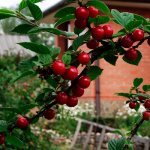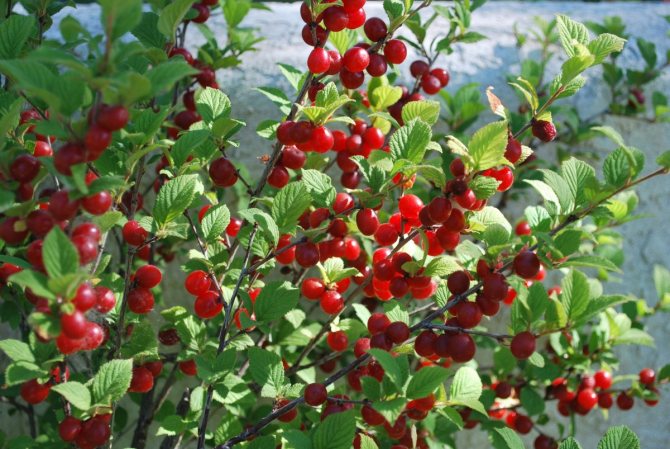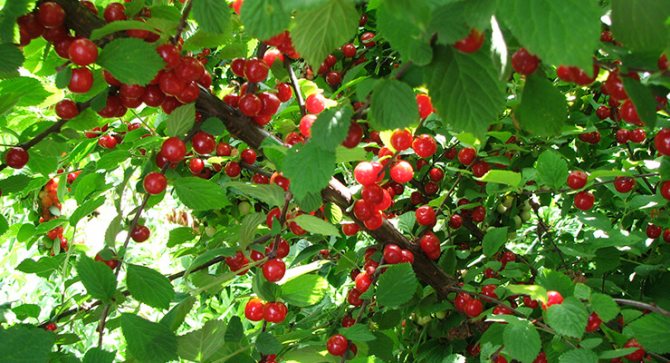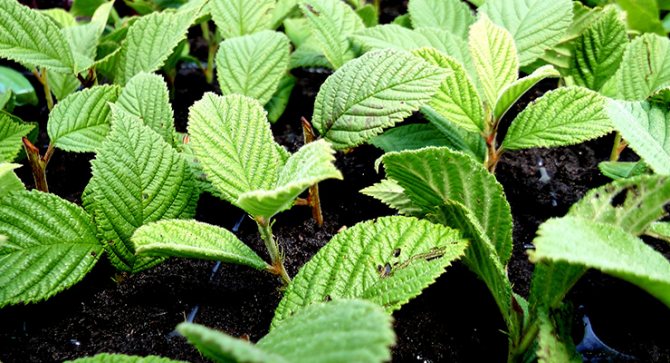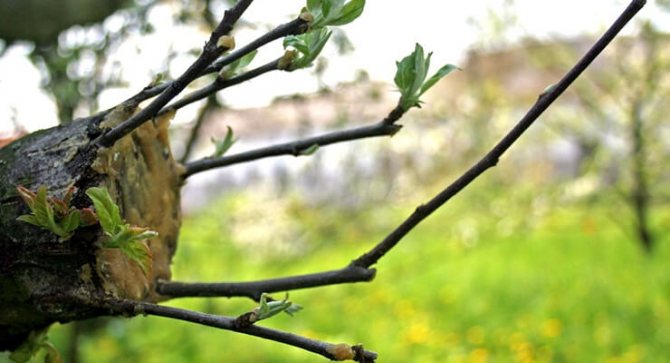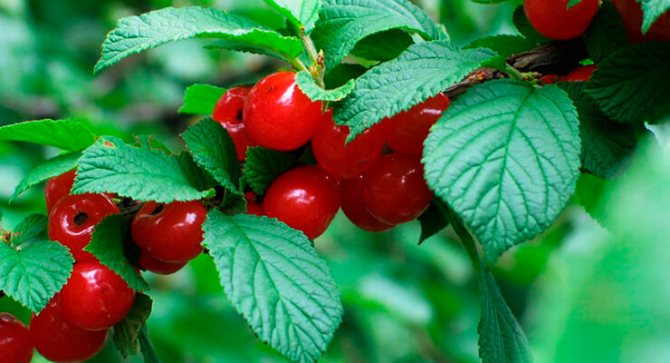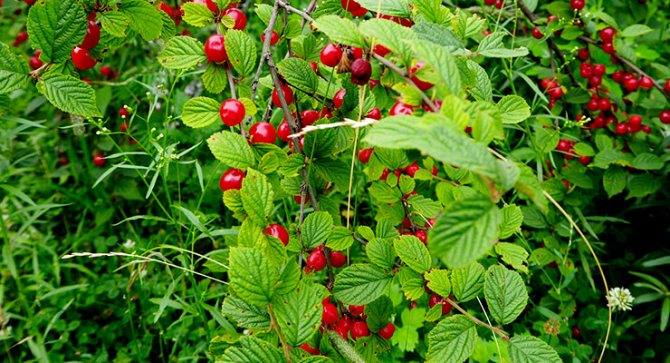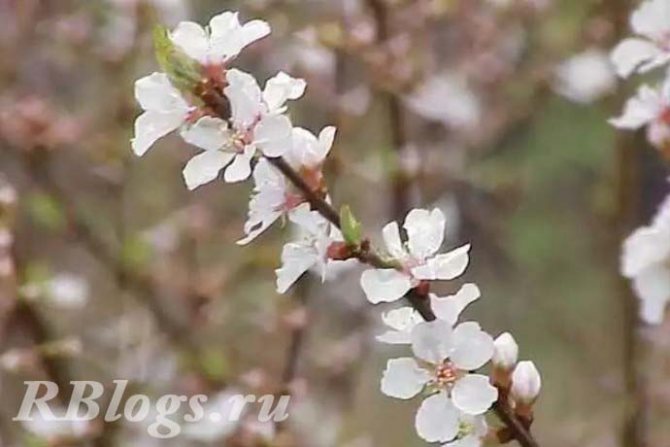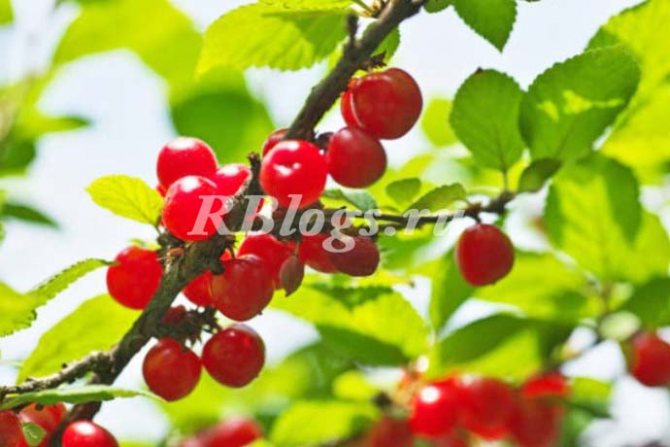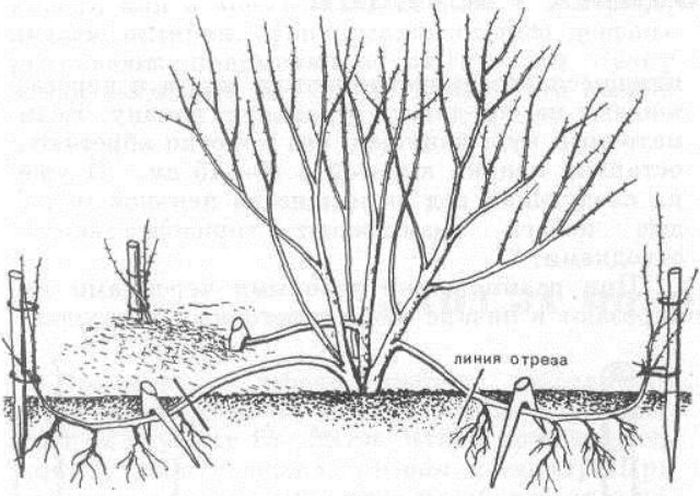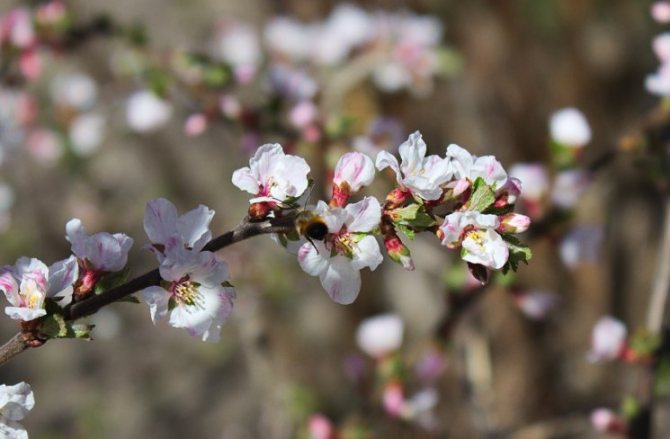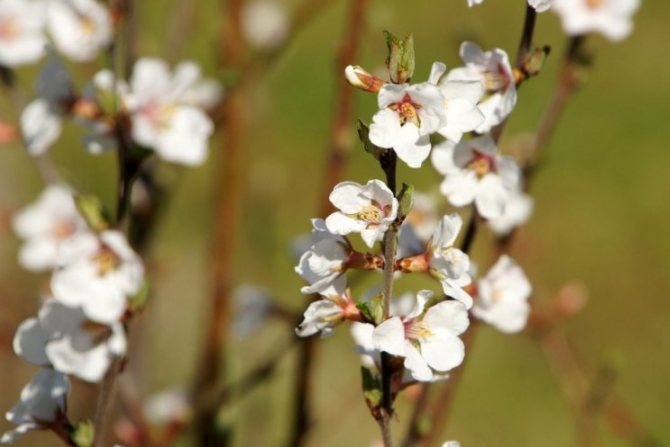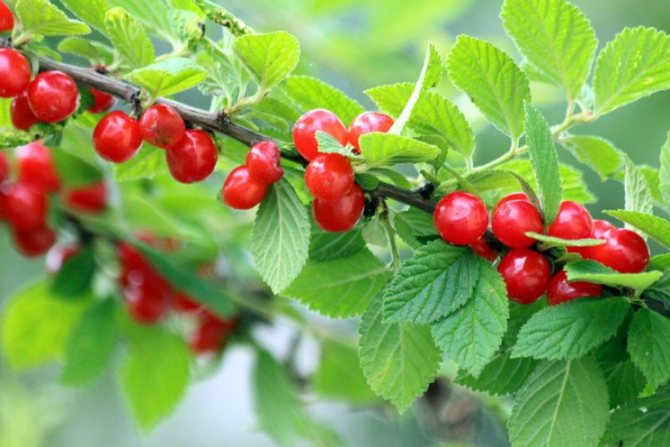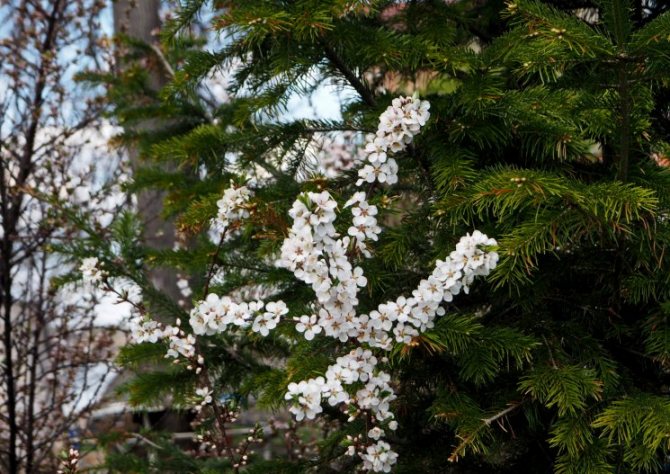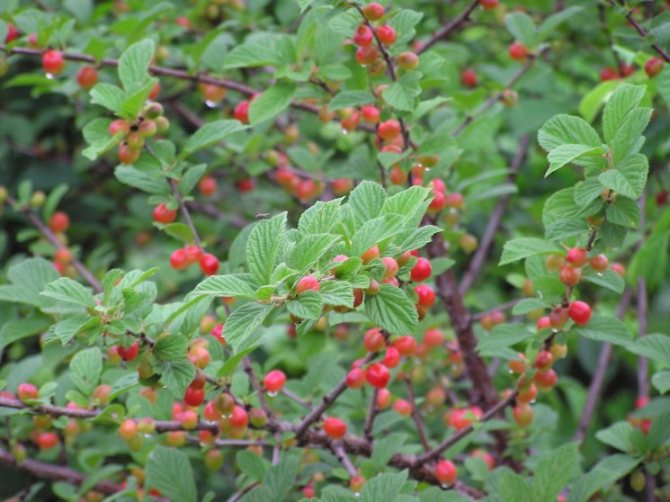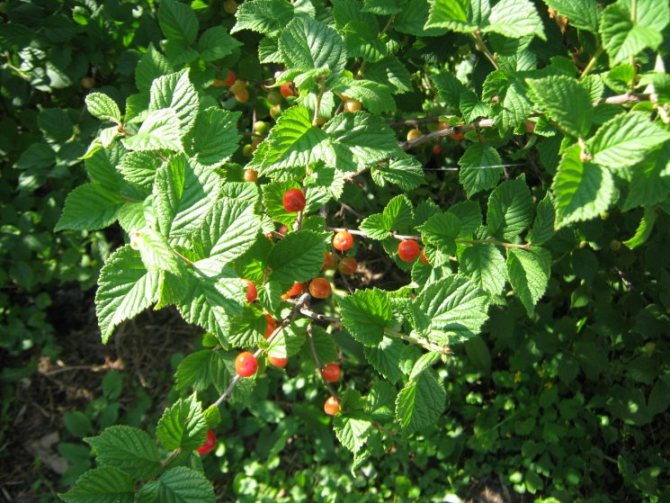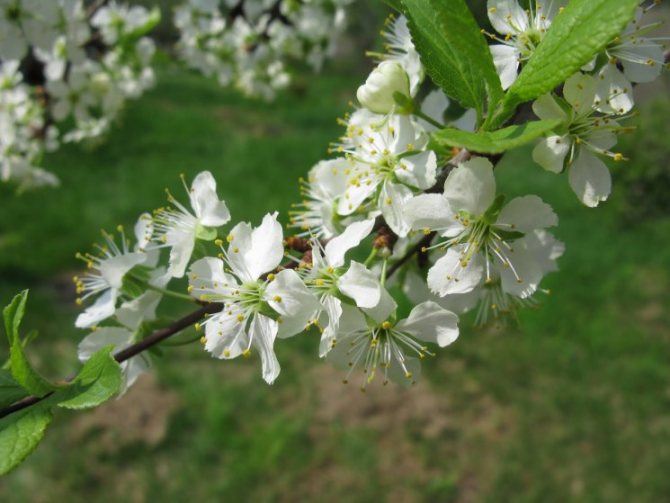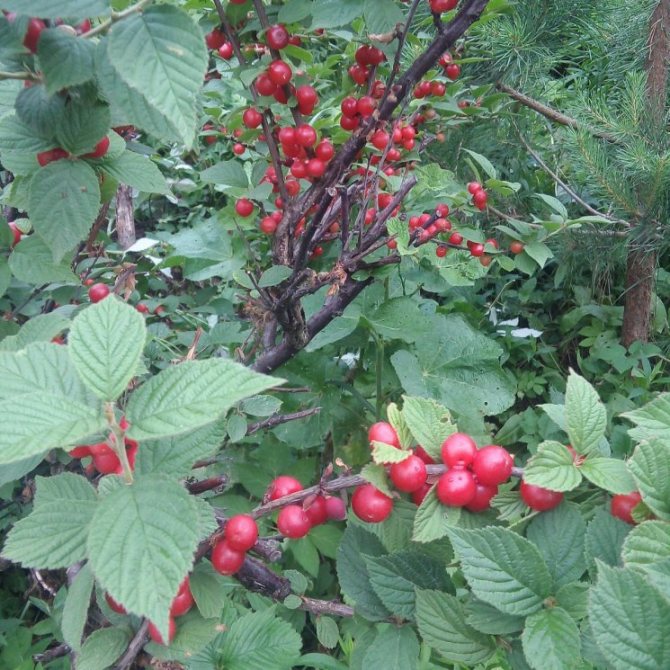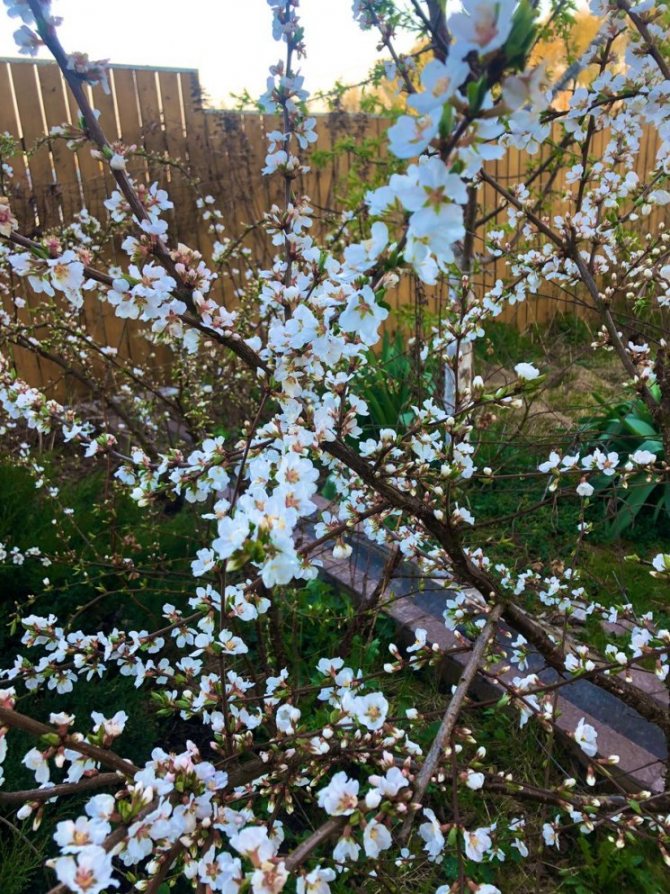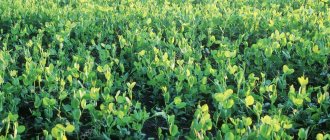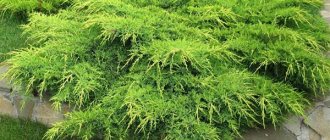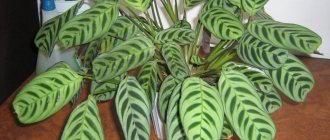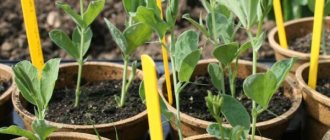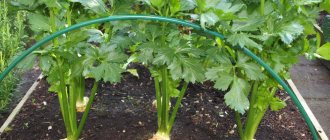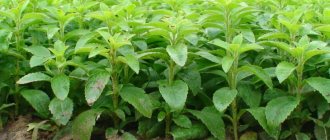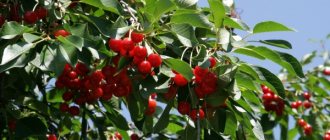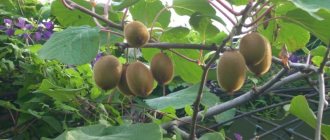Felt cherry, despite its name, is closely related to plum, cherry plum, apricot, and has a very distant relationship to ordinary cherry. The second name of the culture is Chinese cherry, although Korea and Mongolia are homelands to the same extent. Felt cherry became widespread in Russia, as well as in the temperate latitudes of North America and Europe, around the middle of the 20th century. and immediately fell in love with gardeners for a number of advantages:
- Despite its small size, it gives 8-10 kg of berries, and with good care - up to 15 kg of fruits from one plant;
- Differs in high frost and drought resistance;
- The shrub grows rapidly and begins to bear fruit early;
- A distinctive feature - the fruits do not crumble even after ripening;
- Felt cherry bushes are small in size and do not require large areas for planting;
- The plant is highly decorative both during and after flowering, therefore it will perfectly decorate any garden;
- Planting and caring for the cultivation of felt cherries is simple and inexpensive, so growing a shrub is available even to amateurs.
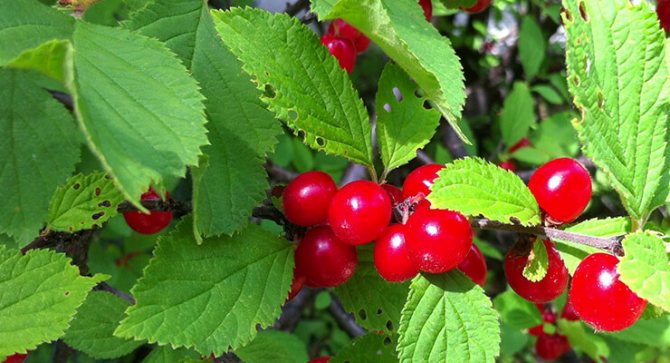
general description
Felt cherry is a small tree or shrub with several trunks from 150 to 250 cm in height. Some varieties can grow up to 300 cm under high cultivation culture. The plant owes its name to pubescent shoots, leaves, and often berries. Outwardly, felt cherry is very different from ordinary cherry. Its leaves are small, strongly corrugated and covered with soft fluff, young shoots are greenish-brown.
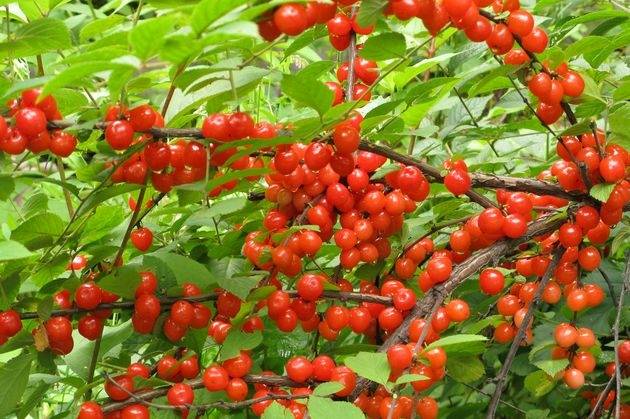

Flowers can be white or all shades of pink. In the spring, they appear earlier or simultaneously with the leaves and cover the bush so abundantly that it looks like a huge bouquet. Felt cherry berries are small, with a diameter of 0.8 to 1.5 cm, occasionally 3 cm (hybrid with a cherry). They are attached to short stalks and look like pink, red, in some varieties, almost black beads.
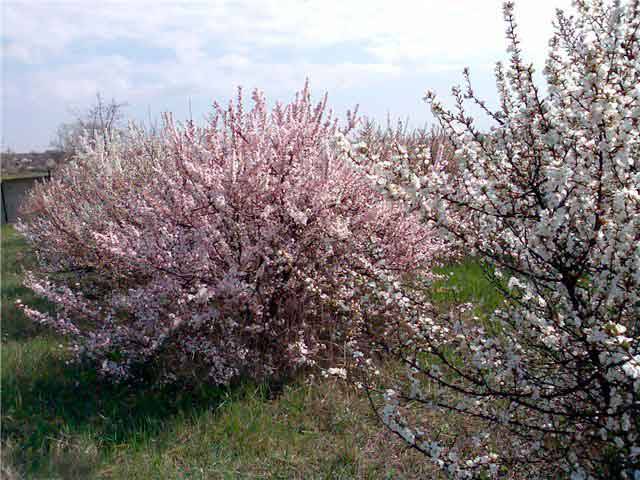

The taste of berries is sweet, bland, with absolutely no bitterness or astringency. Sourness may be present, often light, less often pronounced. The oblong pointed bone does not separate from the pulp. It is almost impossible to pick felt cherries without damaging the juicy berries, because of this, its transportability is low. In recent years, varieties with gristly elastic flesh have been created. The yield varies greatly depending on the variety, weather conditions, care and ranges from 3 to 14 kg per bush.
Felt cherries begin to bear fruit early:
- grown from a bone - for 3-4 years;
- obtained from the cuttings - 2-3 years after planting;
- vaccinated - next year.
Berries ripen about a week earlier than other species - steppe, sandy, ordinary.
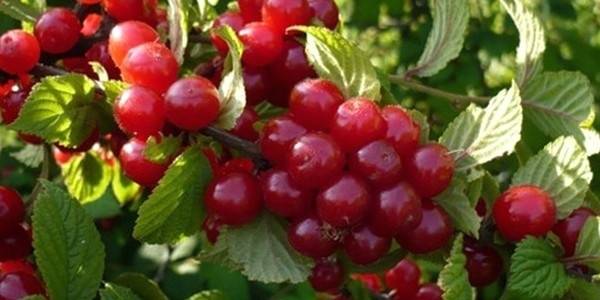

Comment! Children especially love felt cherries.
Inventory
Garden tools must be of high quality and safe to use. To carry out work on pruning trees, use:
- secateurs, for removing branches up to 3 cm in diameter and young shoots;
- lopper, for work in hard-to-reach places and at the top of trees;
- a hacksaw or a garden saw, for cutting branches over 5 cm;
- stepladder, for working on high varieties of cherries.
Garden supplies must be kept clean after work, this will reduce the likelihood of transmission of the disease from an infected tree to a healthy one. Another important condition is that the tools must be sharp in order to cut the branches neatly and without chipping.
Working with gardening gloves will protect your hands from injury. It is advisable to use latex, tarp or leather gloves.
Growing features
Most varieties of Chinese cherry trees require cross-pollination. Therefore, you need to plant several varieties, or place a plum or apricot next to it. There are also self-pollinated varieties of felt cherries.
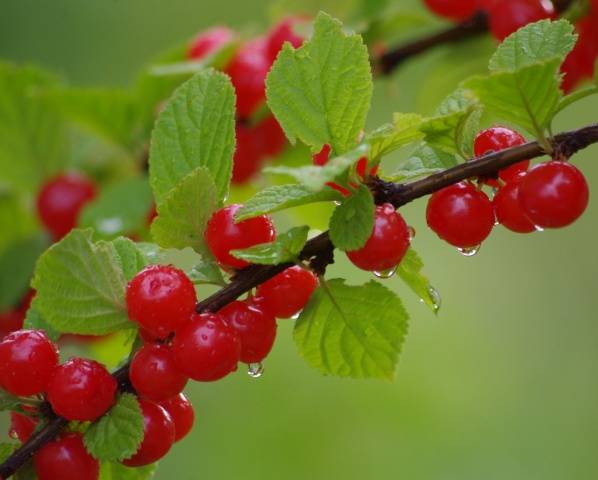

The plant can withstand frosts up to 40 degrees, prefers sunny places and absolutely cannot stand water stagnation at the roots. After full ripening, the berries stay on the bush, without losing their attractiveness and taste for a very long time. Felt cherry is resistant to the scourge of other species - coccomycosis. It bears fruit every year well, but requires regular sanitary and shaping pruning.
More tips for growing this crop will be given by the video about the felt cherry:
Pruning depending on the shape of the tree
Cherry trees are of two types: treelike and bushy. The formation of the crown and the location of the fruits occurs in different ways, therefore, care has its own nuances.
In bush varieties, flower buds are located only on annual growths, and in tree varieties - on growths of previous years, bouquet twigs, annual shoots.
Bush cherry
Bush cherry varieties thrive in summer. In the fall, the crown is carefully thinned out. Shoots, dry and affected branches are also removed. In order for the plant not to lose its strength and yield, the following conditions are met:
- young shoots are not cut off (the branch may dry out);
- the branches of the crown are directed outward;
- bushes up to 50 cm long are left intact;
- the bare ends of the branches are cut off by 30-50 percent of the total length;
If the growth of bush cherries is less than 20 cm per year, intensive cleaning is carried out.
Tree cherry
The height of such a tree can reach 5 meters due to strong skeletal branches, therefore, in addition to thinning, it is shortened at a young age.
Unlike bush cherries, annual shoots are pruned in tree ones. This stimulates the development of lateral branches. Gardeners prefer a combined or sparse-tiered system when caring for tree varieties.
Main problems
The cultivation of the Chinese cherry comes with some difficulties. In recent years, she has suffered greatly from a monilial burn. In this destructive disease, the flowers and leaves first wither, then the branches begin to die off. If you do not remove the affected shoots, capturing 15-20 cm of healthy wood, the entire bush may disappear.
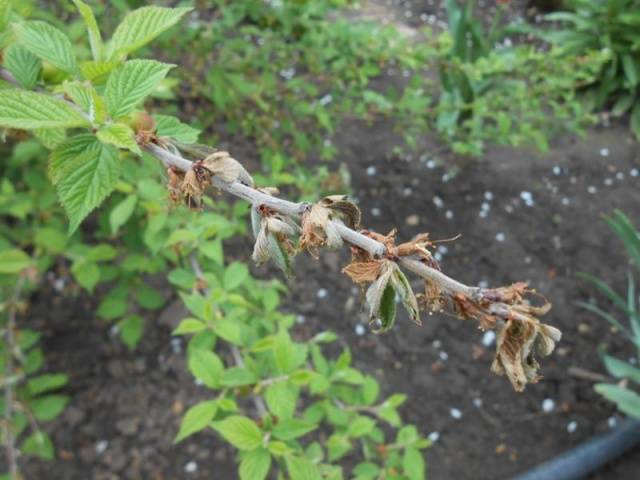

Where there is a high likelihood of return frost, medium and late varieties should be grown. The Chinese woman begins to bloom early, the buds can suffer not only from low temperatures, but also due to the absence of bees or bumblebees pollinating the plant.
Although felt cherry easily tolerates frost up to 40 degrees, in especially harsh winters, the cambium (part of the shoot between the wood and bark) and the core can freeze on old branches. They have to be cut out mercilessly, capturing a piece of healthy tissue.
The next problem is the drying out of the root collar, which happens from waterlogging of the soil in late summer or autumn, when the plantings are flooded when the snow melts. To avoid trouble, cherries are placed on hills or other areas where snow does not linger. If this cannot be done, not a tree that is rooted or grown from a seed is planted, but grafted on a stem that is resistant to soaking.
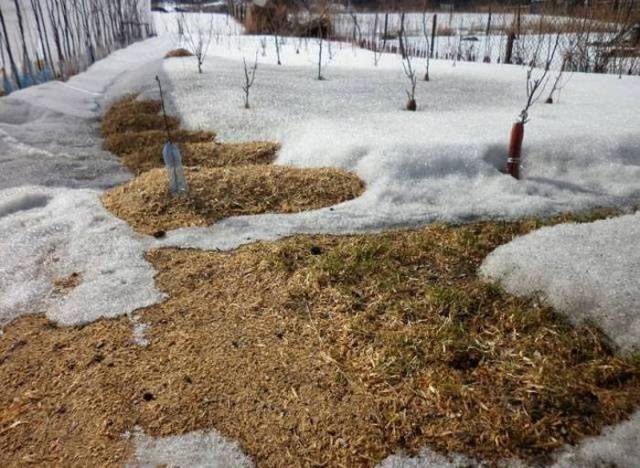

Garden var
This is a special putty, which is used to treat damage on the bark or cut. You can buy putty at specialty stores, but it's easier to make your own.
Types of putty on:
- paraffin wax;
- wax;
- wood alcohol;
- lard.
Paraffin putty is prepared from a kilogram of paraffin, rosin and nigrol. The ingredients should be heated separately, and then the paraffin and rosin should be carefully poured into the nigrol. Wood ash can be added to the putty before use. Apply warm.
The recipe for wood alcohol putty includes rosin and lard (ghee). First, mix rosin (16 parts) with bacon (1), heat well. Then alcohol (8 parts) is added to the mixture, kneaded until a homogeneous consistency.
The cost of a beeswax mixture on the market is high. To create a putty, take 4 parts of wax, 20 linseed oil and 1 resin or rosin. When the mixture of wax and resin reaches a homogeneous consistency (it is heated), you need to add linseed oil. After boiling, crushed charcoal (2 parts) is poured over the var.
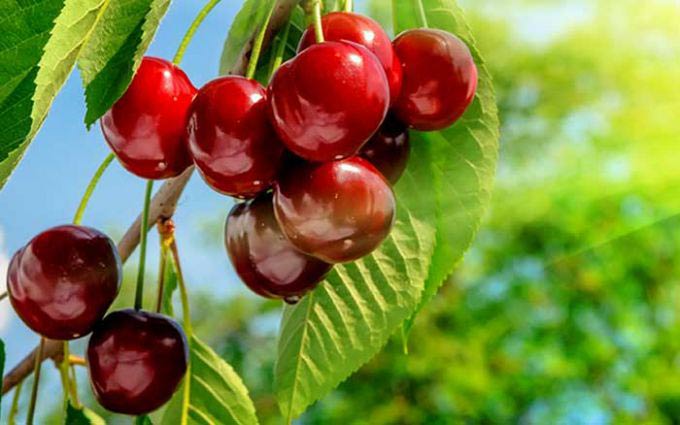

Agrarians recommend adding heteroauxin to the putty. One tablet is consumed per liter of vara. In cold regions, the cuts are treated with a protective compound against frost.
Putty on lard is prepared as follows. Softened wax is mixed into the melted bacon without greaves (lard) and the mixture is brought to a homogeneous state. The proportions of fat and wax are 2: 1. Then add crushed rosin (4 parts) and bring to a boiling state. Keep on fire for half an hour, then poured into cold water. Knead the mixture in water.
At what time of the year can you cover trees with garden pitch? There are no restrictions on the use of putty, it is used as needed.
Recommendations for the selection of varieties
When choosing a variety for the garden, it is not enough to look at a photo of a felt cherry and buy the one you like. The plant must be designated for planting in your area. It is also necessary to pay attention to the reviews of gardeners about felt cherries exclusively on a territorial basis. If a variety feels good and bears fruit abundantly in the Moscow region, it is quite possible that growing it in the Leningrad region will bring disappointment.
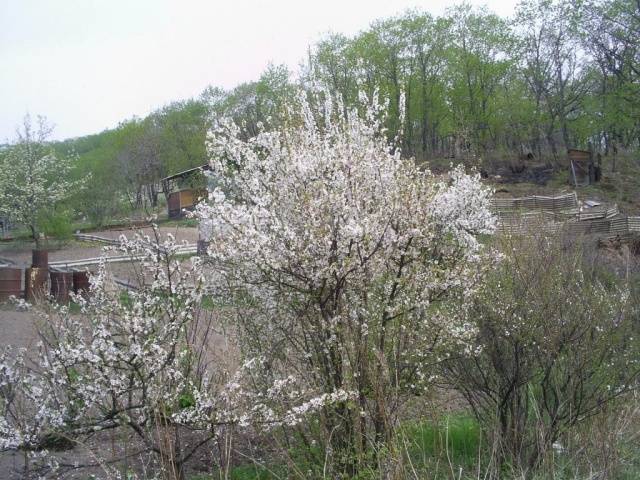

Pay attention to the timing of cherry ripening - planting just a few bushes can extend the collection of berries for more than a month. In addition, early varieties should not be purchased by residents of regions where the likelihood of return frosts is high.
The habit of the bush also matters - no matter how we console ourselves that this cherry is small, it can grow up to 2.5 meters, and you need to plant several bushes. In addition, the plant is very picky in choosing a place - it will be accepted almost everywhere, but in lowlands or under a thick snow cover it can die in the first thaw. In areas of a small area, it makes sense to plant bush felt cherry, branching directly from the base of the trunk.
Comment! The plant is so attractive that it is often used for decorative purposes.
Getting rid of vertical shoots
Pay attention to the vertical shoots - these are tops (felt cherries also have them). They are useless, pull off nutrients and do not produce fruit. Such shoots can be cut into a ring or, leaving the strongest from the heels, try to bend them by tying twine to them and tying them to the shoot located below.
Then the branch bent at an angle close to 900 can begin to bear fruit, and if it breaks during the bending process, then cut it into a ring. By the way, in the future, follow the constrictions, and use twine, and not wire, which very easily cuts into the shoots. If you are worried about your tree, then put a piece of rubber between the twine and the shoots, which will protect the bark from injury. It is appropriate to carry out this procedure in March or early April, when the branches of the felt cherry are as pliable as possible.
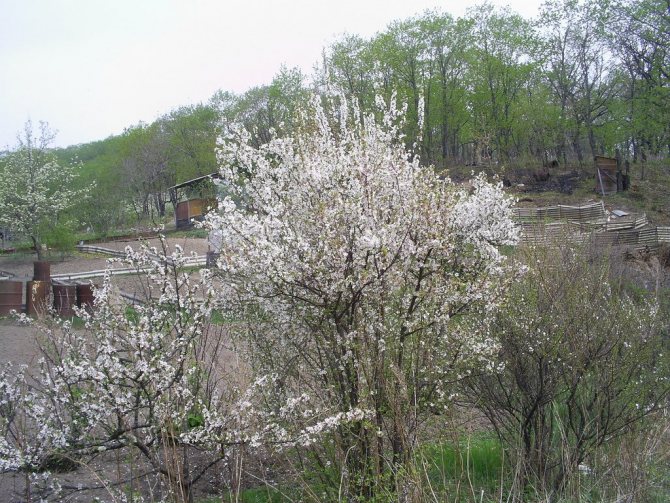

Even very old and neglected felt cherries can be rejuvenated by pruning. <>
Felt cherry varieties for the Moscow region
The most difficult thing is to find the best varieties of felt cherries for the Moscow region. From the photos of numerous online stores, elegant bushes with red berries look at the consumer, and advertising claims that the plants will take root well. Of course, the Chinese cherry is unpretentious, but only in the Far East.
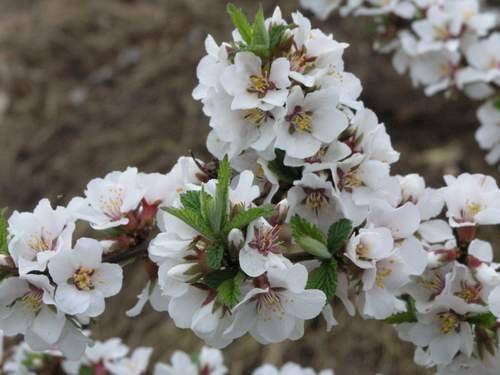

In the Moscow region and other regions of the Middle Lane, such troubles as recurrent frosts and damping of the neck lie in wait for it. The plant does not like the acidic dense soil - it needs to be improved by adding lime, a large amount of organic matter and ash.
In fact, any varieties allowed for cultivation in all regions are suitable for the Moscow region, if you choose an elevated place for planting and cultivate the soil. It is important in no case to buy seedlings brought from the southern regions, Moldova or Ukraine. They are almost 100% unlikely to survive the winter.
Among other varieties suitable for planting in the Moscow region, I would like to highlight:
- Alice;
- Natalie;
- Fairy tale;
- Triana;
- Anniversary;
- Altan;
- Damanka;
- Beauty;
- Summer;
- Dream.
There is no point in worrying about self-fertile varieties of felt cherries for the Moscow region. It is difficult to find an area that does not have plums or apricots. And in places where these trees are not within a radius of 40 m, there are no felt cherries.
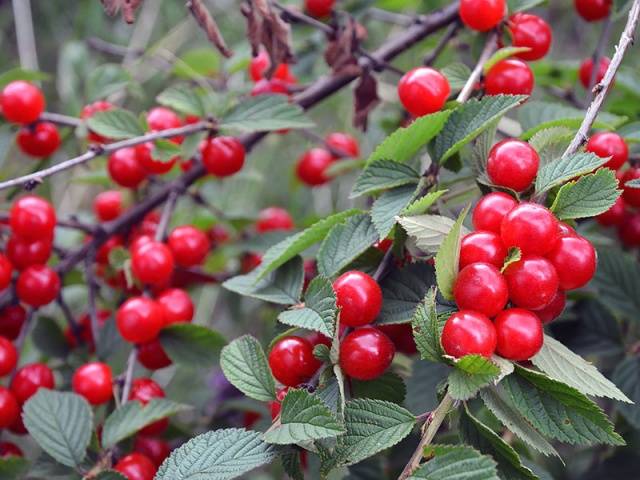

Comment! In the Moscow region, the Chinese woman should not become the main crop, she is just a good addition to your table, and not a replacement for ordinary cherries.
Notes, hints and tips
For those who are just starting to prune cherry trees, it will be useful to heed the recommendations of experienced gardeners:
- Before the formation of the crown, the top of the trunk is filed to the optimal height and only after that the crown is cleared of unnecessary shoots.
- If in doubt, which branches to cut, then look at the buds. Branches with fewer buds are cut off.
- An excess of unnecessary branches from one tree is removed over several seasons.
- Young cherries are not cut off too much, otherwise the fruit will become smaller.
- The branches of a biennial tree that have grown more than 60 cm are shortened by a third.
- Horizontal branches give a good harvest of berries. It is necessary to ensure that they grow upward.
- Shoots of the first tier growing down are pruned.
- To increase yields, the growth of the tree is limited to 3 m. At the same time, it is observed that the central stem is 20 cm higher than the upper branches.
Some summer residents are guided by the lunar calendar before pruning. The days are considered auspicious when the moon decreases and before the new moon.
It is useful for beginner gardeners to study the device of a cherry tree, to learn to distinguish between growths, vegetative and bouquet branches. Pruning correctly helps cherry trees withstand the cold winter more easily and increases their lifespan.
Felt cherry varieties for Siberia and the Urals
It makes no sense to list the varieties growing in the Urals and Siberia. Almost all cultivars of felt cherry were bred in the Far East, the overwhelming majority - by the experimental station of the N.I. N.I. Vavilov. Climatic conditions make it possible to plant a Chinese woman not only in gardens, but also as a hedge or to strengthen the slopes.
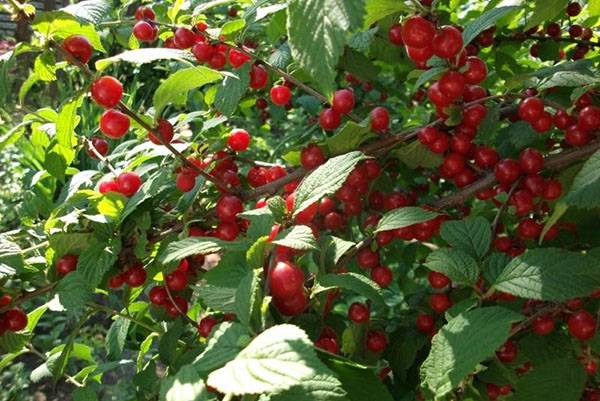

In the northernmost regions, where the temperature in winter drops below 40 degrees and there is a danger of freezing of the cambium, it is recommended to grow the Chinese as a creeping crop. To do this, the bush is planted at an angle of 45 degrees, and covered with spruce branches for the winter.
Favorable time for pruning
Each region has its own terms of the procedure:
- in central Russia, the Volga region, Moscow, Leningrad regions - this is September-mid-October;
- for the Urals and Siberia - no later than the end of September;
- in the south of the country, pruning is carried out in November.
Pruning cherry trees along with leaves is only possible in warm regions. In other areas, the procedure is carried out before shedding the foliage.
The main condition is not to wait for severe frosts, otherwise the winter hardiness of the plant will decrease. The branches are cut in dry weather, before the onset of cold weather.
How to choose a felt cherry for the Leningrad region
In the Northwest, the climate is unstable. Spring thaws give way to frosts - this is the return frost, dangerous for felt cherries. Plants overwinter well, but the root collar often blows out. Due to the untimely departure of bees, early Chinese varieties will bloom profusely, but will not be able to bear fruit annually. Better to plant late to medium ripening.
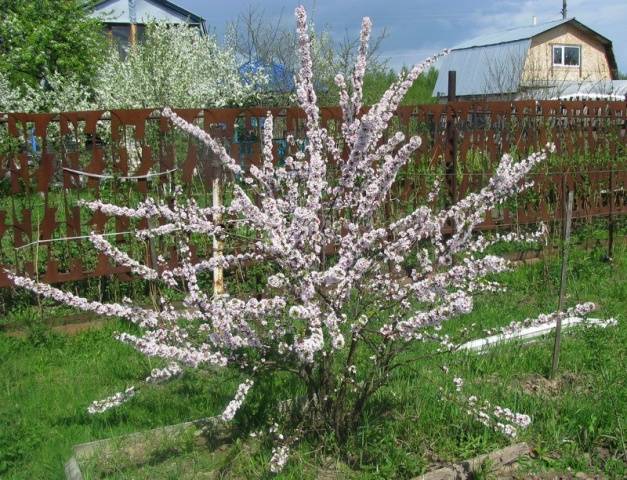

The following varieties have shown themselves well:
- Alice;
- Dream;
- Natalie;
- Story;
- Triana;
- Altana;
- White;
- Damanka.
How to take care of cherries after pruning?
Cutting points are treated with garden varnish, paste or putty. They do this in order to:
- prevent the ingress of bacteria and insects;
- the trees have not lost a lot of fluid (moisture comes out of the wound in the first hours).
To activate the protective forces of a tree, after pruning, a biostimulator "Novosil" is sometimes used (for 10 liters of water, 3 ml of the drug).
Before covering the sections, they carefully cut off the irregularities. The composition is applied to a dry surface with a wooden spatula or spatula.
The best varieties of felt cherries
Now the selection of the Chinese is actively carried out not only in the Far East, where it has long replaced the usual cherry, but also in other regions. This is partly due to an epidemic of coccomycosis that has destroyed most of the orchards, but the increased interest in new varieties also played a role. They differ not only in terms of ripening, but also in size, fruit color, taste. Recently, varieties with gristly pulp have been created, allowing berries to be stored for up to 5 days.
Early ripe
Chinese cherries ripen earlier than usual by almost 10 days. The first red beads are eagerly awaited by children - the size of the bush allows them to pick the fruits on their own, and they like the freshish-sweet taste much more than the sour berries of the steppe. Early maturing varieties can be planted in all regions, except for those where recurrent frosts often occur.
Delight
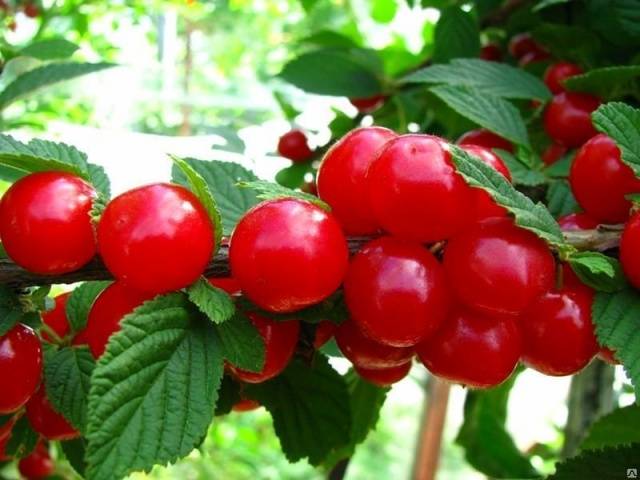

The variety of Chinese cherry Vostorg was created by the Far Eastern Experimental Station in 1999. The bush is rooted, with straight thick shoots forming an oval dense crown, wrinkled small leaves. The berries are bright red, oval, with an average weight of 3.2 g, a tasting rating of 4 points. Variety Delight is self-fertile, resistant to frost and fungal diseases, yields about 9 kg of fruit per bush annually. This cherry is approved for cultivation in all regions, but develops best in the Far East.
Children
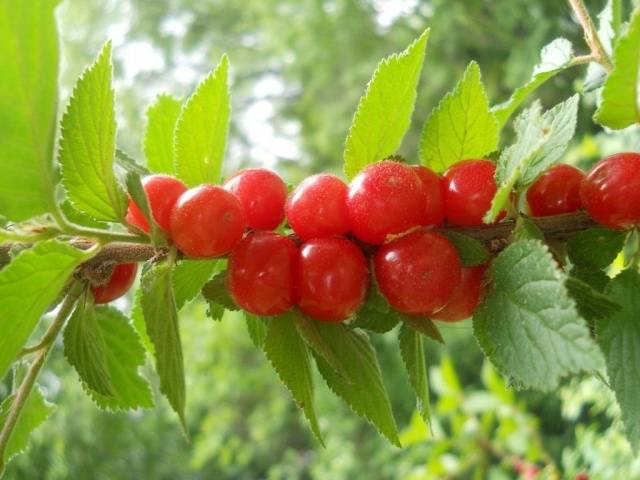

The Detskaya variety was bred in the Far East and adopted by the State Register in 1999. A medium-sized bush, with pubescent brownish-brown branches, a thin broad-oval crown. Fruiting early, comes in the 4th year. The berries are bright red, round, sweet and sour, with gristly flesh. Tasting score - 3.8 points, weight - 3.5 g, average yield - 10 kg. This variety is self-fertile, can be grown in all regions, but will show itself best in the Far East.
The desired
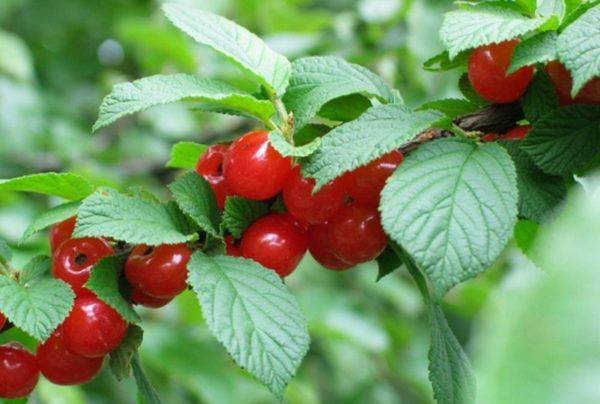

The variety Zhelannaya has a multi-stemmed bush, of medium density, up to 2.5 m high.The berries are dense, dark red, slightly flattened, the average weight is 3.4 g. The taste of the pulp is sweet and sour, the yield is 6.7-12 kg with bush.
Twinkle
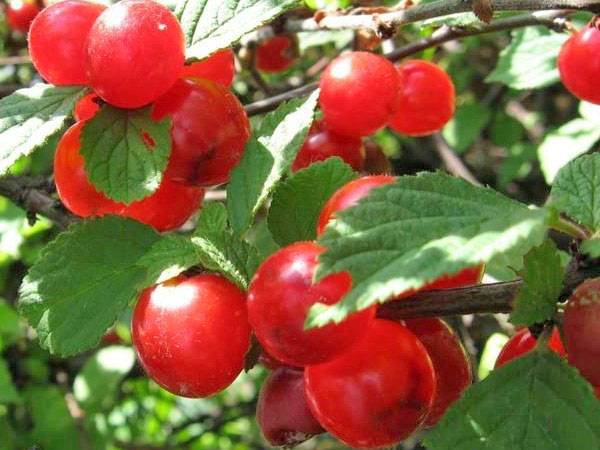

Ogonyok is one of the first Far Eastern varieties, bred in 1965. It grows as a compact bush slightly more than 2 m high, 2.8 m wide with pubescent leaves and pale pink flowers. The berries are pale red, with pink juice, pubescent, their average weight is 2.5 g. The taste is sweet, with sourness, the tasting rating is 4.5 points.
Firework
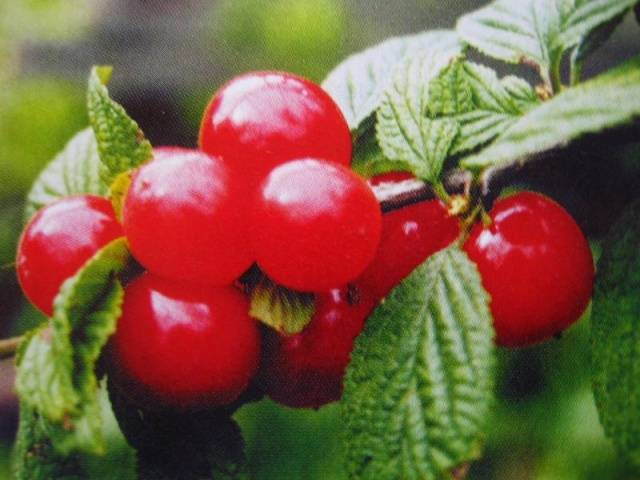

The Salyut variety is self-fertile, its bush grows up to 2 m, the berries are juicy, sweet with sourness, weighing 2-4 g. The stone is small, it does not lag behind the pulp.
Morning
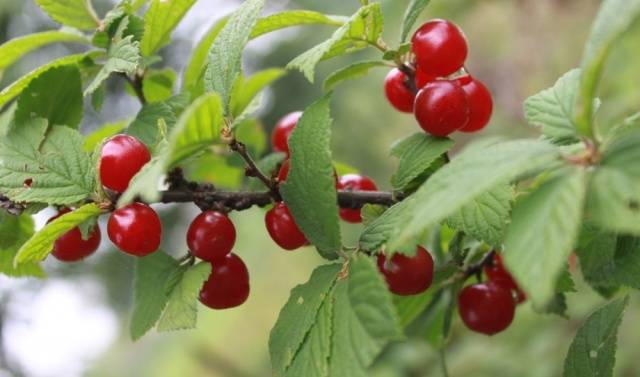

Cherry Morning is self-fertile, with a compact crown, grows quickly. The berries are small (up to 3 g), medium-early ripening, juicy, red, with an almost smooth skin.The yield of an adult bush is 9 kg. Variety Morning is resistant to fungal diseases.
Gypsy
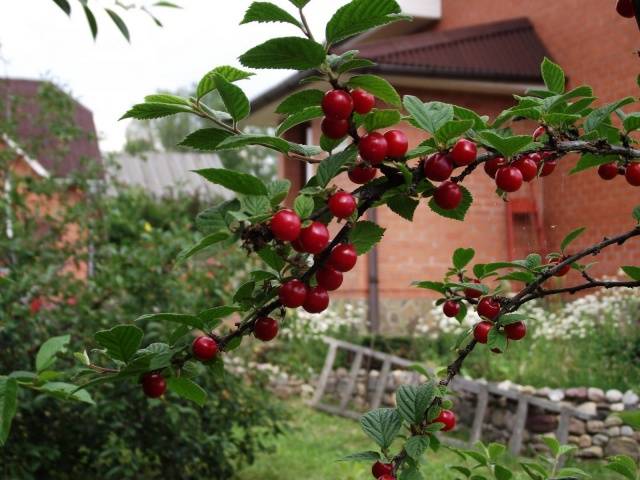

The early variety Tsyganka forms a medium-sized bush. The berries are large, dark cherry, sweet, very tasty, ripen at the same time. The average yield of an adult bush is 8-10 kg. Seedlings of felt cherry Gypsy do not tolerate waterlogging. The variety is resistant to drought, recurrent frosts and diseases.
Mid-season
The most numerous group of felt cherries is formed by mid-season varieties. They suffer less from recurrent frosts than early ones.
Amurka
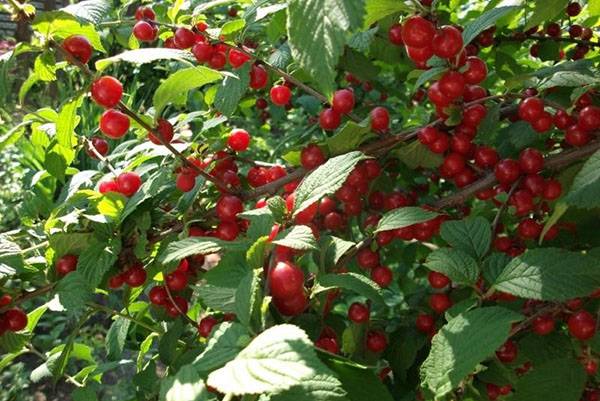

This variety is zoned in the Primorsky and Khabarovsk Territories, bred in the Far Research Institute of Agriculture. Bushes are tall, with sparse branching. Shoots are medium in thickness, strongly pubescent, old branches are curved. Fruits usually weighing 2.7 g are claret-red, glossy, sweet and sour, with a liquid pulp. Cupid is grafted onto wild-growing felt cherry or Ussuri plum.
Alice
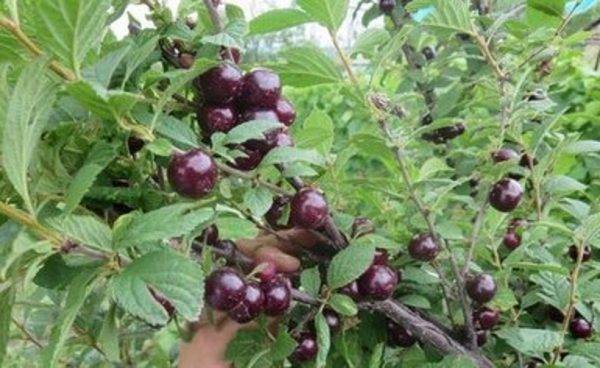

Variety Alisa, bred by the Far Eastern Experimental Station, was adopted by the State Register in 1997. A bush with pubescent brown shoots forms a crown of medium density. Dark-burgundy berries with juicy pulp are one-dimensional, their weight reaches 3.3 g, the assessment of tasters is 4.5 points. Alice is a self-fertile and disease-resistant variety.
Okeanskaya Virovskaya
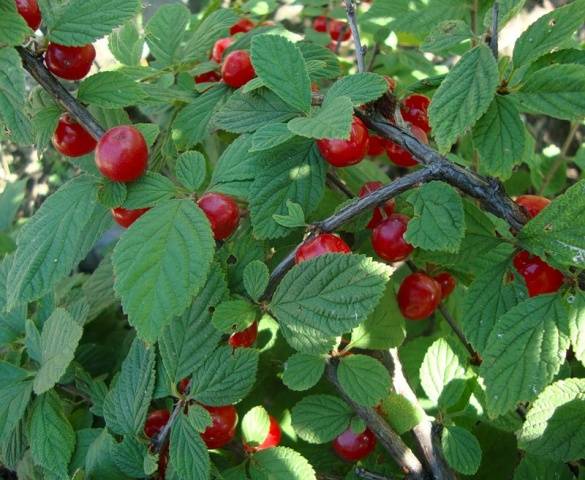

This variety was created in the Far East in 1987, the year of adoption by the State Register is 1996. Okeanskaya Virovskaya is approved for cultivation throughout Russia, but bears fruit best of all in its native region. Own-rooted bush, medium size, crown - paniculate. The variety begins to bear fruit in the 3rd year. The berries are claret, with cartilaginous dark red flesh. Tasting mark - 4 points, fruit taste - sweet and sour.
Natalie
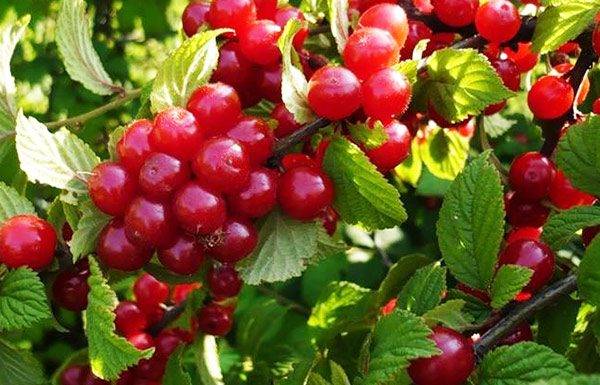

Chinese cherry Natalie was adopted by the State Register in 1997, the originator is the Far Eastern Experimental Station. The variety is universal, grown in all regions of the Russian Federation. A tall bush with medium density of brown branches, for 3 or 4 years it enters full fruiting. Berries with a semi-dry separation, dark red color, one-dimensional, weighing 4 g. Natalie has a high taste rating - 4.5 points, the flesh is gristly, red, sweet-sour.
Pioneer
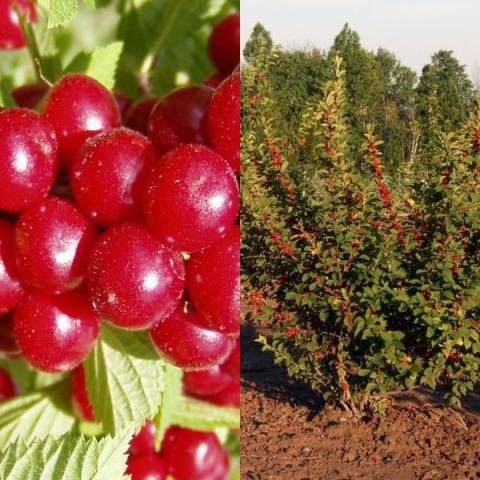

The Pionerka variety is one of the first varieties created by the V.I. Vavilov. It forms a bush 1.5-2 m tall, with elastic thin branches. Bright red fruits weighing 2.8 g are flattened, uneven. The Pionerka variety requires pollination.
Pink harvest
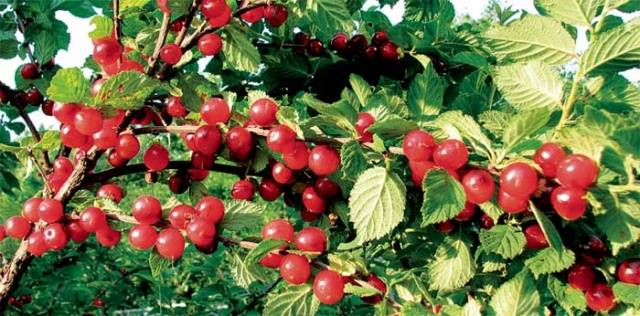

The Rozovaya Urozhainaya variety, created in the Far East, is in the State Grade Testing. Forms a sprawling bush of medium height with pubescent shoots and leaves. Berries weighing about 3 g are pink, rounded-flattened. The pulp is pleasant to the taste, sweet, with sourness, the tasting score is 4 points. The first berries on the scion appear in the second year. The yield of the bush is up to 9 kg. Recommended for growing in the Far East.
Dark-haired East
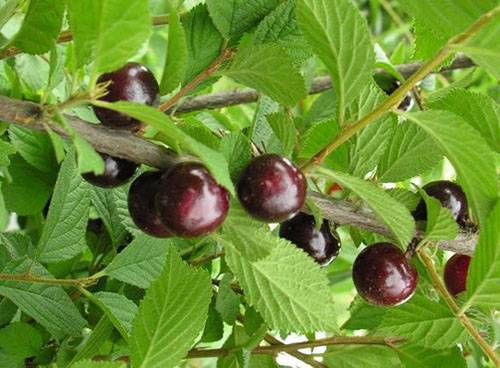

This variety was registered by the State Register in 1999, created by the Institute. Vavilov, can grow in all regions, but it develops best at home. Dark-skinned Vostochnaya is self-fertile, forms a small bush with a dense wide crown, strongly pubescent shoots and leaves. Dark-burgundy berries of wide-oval shape, weighing 2.5 g. The taste of sweet-sour pulp was rated 4. The yield of the variety is 7 kg per plant.
Story
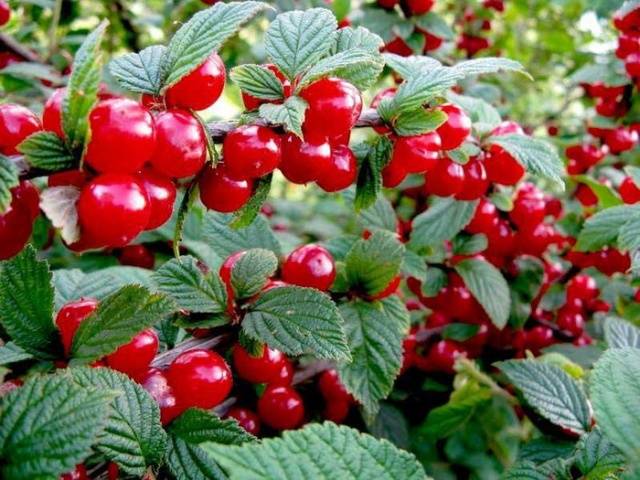

This self-infertile variety was registered by the State Register in 1999 and approved for cultivation on the territory of all regions of the Russian Federation. A medium-sized self-rooted bush with an oval crown begins to bear fruit in the 4th year. Berries are maroon, oval, weighing 3.3 g. Cartilaginous flesh is sweet and sour, tasters' assessment - 3.8 points. Berries up to 10 kg are harvested from the bush.
Triana
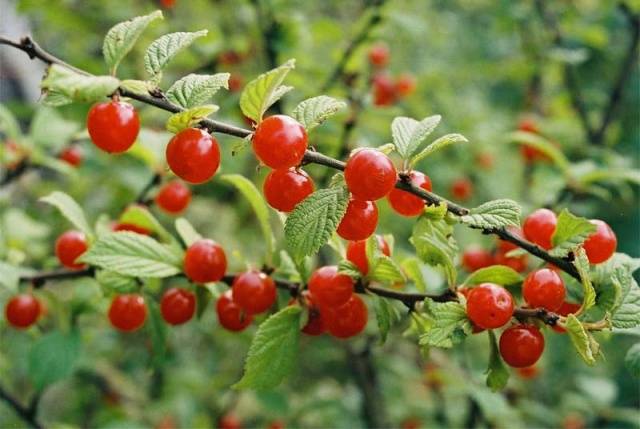

Triana was created in the Far East, registered in 1999 by the State Register and approved for cultivation in all regions. Forms a medium-sized bush with an elongated oval crown.Dark pink fruits with a taste of 3.8 points are broad-oval, weighing 3.7 g. The taste of berries is sweet-sour, and the flesh is firm, like a sweet cherry. The variety is self-fertile, resistant to fungal diseases, yields 10 kg.
Princess
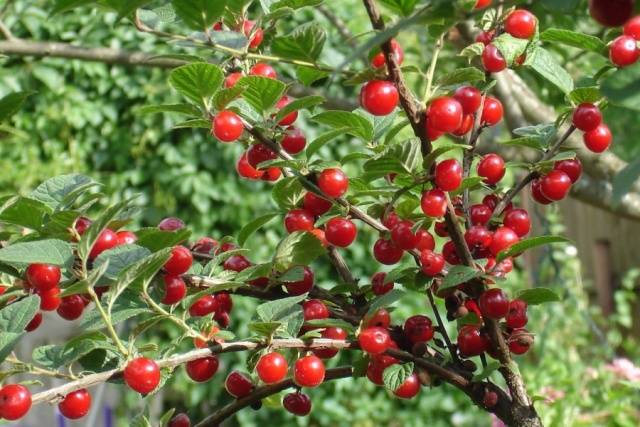

Self-infertile variety Princess of universal purpose, created by the Institute. Vavilov and was registered in 1999. A small bush with a spreading crown can be grown in all regions, forms a good harvest by the 4th year. The berries weighing 3.6 g are bright pink in color, with a tight red flesh. The taste of the fruit is sweet and sour, rated by the tasters at 3.8 points. The average yield per bush is 10 kg.
Anniversary
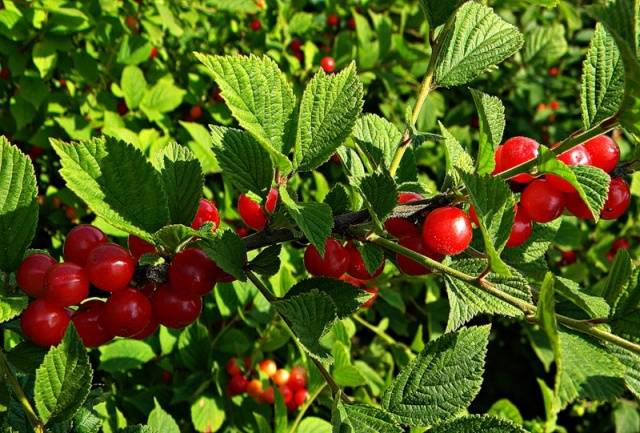

The Far Eastern variety Yubileinaya, adopted in 1999 by the State Register, can grow in all regions. A medium-sized bush with an oval crown begins to yield in the 4th year. Oval fruits are burgundy, weighing about 3.5 g, with a taste rating of 4.3 points, sweet and sour. The average yield of an adult bush is 9 kg.
Khabarovsk
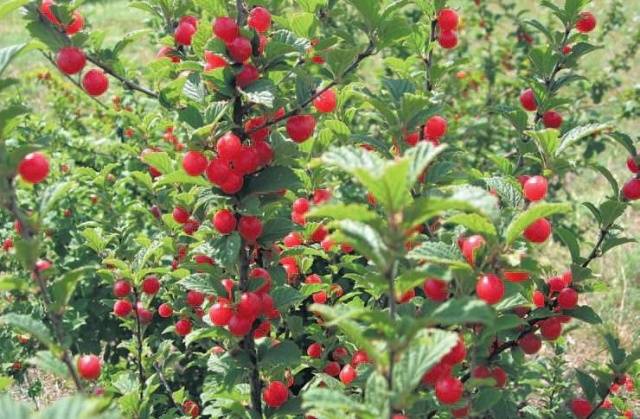

The Khabarovsk variety has an increased winter hardiness. Medium-sized shrub with pubescent shoots and leaves, gives pink fruits weighing about 3 g. The taste of the berries is sweet, the shape is slightly flattened.
Late ripening
Late-ripening varieties are boldly grown in any region - they suffer the least from neck decay and recurrent frosts. Although by the time the berries ripen, ordinary and steppe cherries often come into fruition, felt cherries will not be left unattended - children love them very much.
Altana
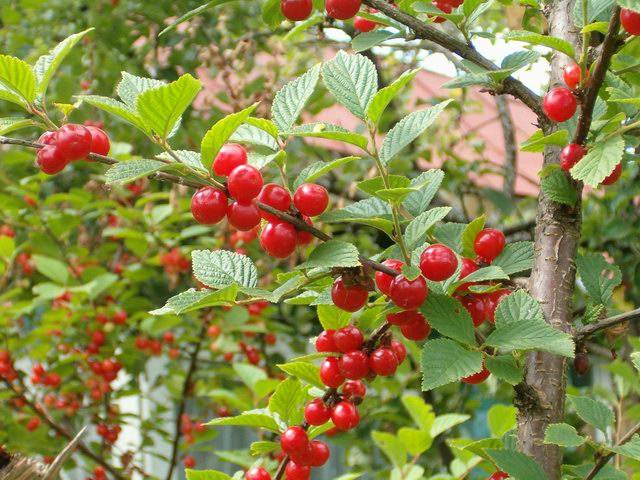

The Atlanta variety was created by the Buryat Research Institute of Agriculture in 2000. In 2005, it was adopted by the State Register and approved for cultivation throughout Russia. Altana is a felt cherry with a dense round crown that begins to bear fruit in the 4th year after planting. Thin straight shoots and leaves are heavily pubescent. One-dimensional dark red berries gain weight in 2 g. Fruits are juicy, tender, sour-sweet, their taste is estimated at 5 points. The variety is characterized as resistant to fungal diseases.
White
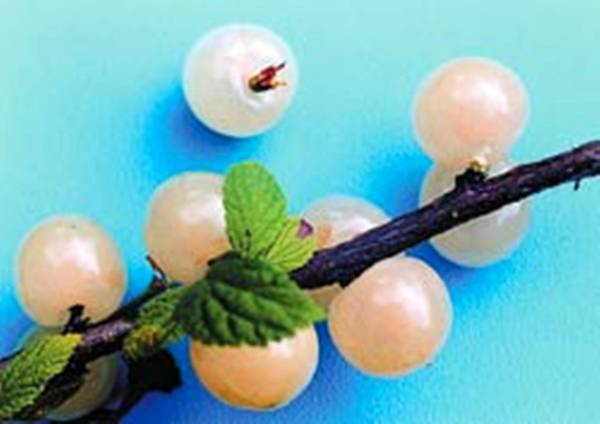

The Belaya Cherry felt variety, registered in 2009, belongs to the Far Eastern selection and is recommended for cultivation in all regions. Forms a tree with a spreading crown, pubescent shoots and curved wrinkled leaves. Wide-oval fruits weighing 1.6 g are white, pleasant to the taste. The tasting score is 3.6 points. The Belaya variety from 2011 to 2041 is protected by a protective patent.
Damanka
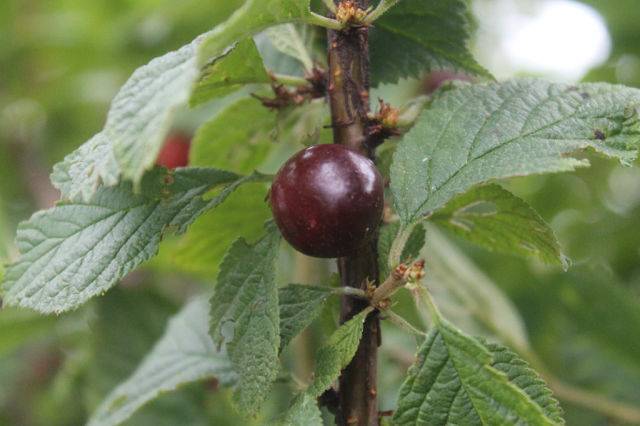

Many consider Damanka to be the most delicious variety of Chinese. It was created with the participation of sand cherries; among others, it stands out for the almost black color of the fruit. Berries weighing more than 3 g each, shiny and very beautiful. The Damanka variety is distinguished by its early maturity and rapid growth, even self-rooted plants give a decent harvest already in the third year. This cherry is self-fertile, with a yield of 8 kg per bush.
Marvelous
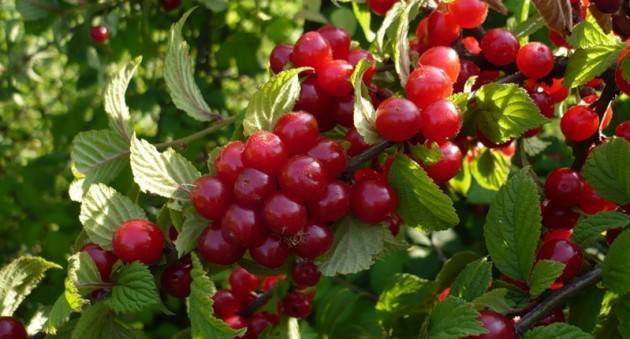

Variety Divnaya grows in a bush about 2 m high. The crown is dense, shoots and leaves are abundantly covered with bristles. Round berries with a thin skin and sweet-sour flesh are scarlet-red. Fruiting profuse from 3-4 years of age.
Beauty
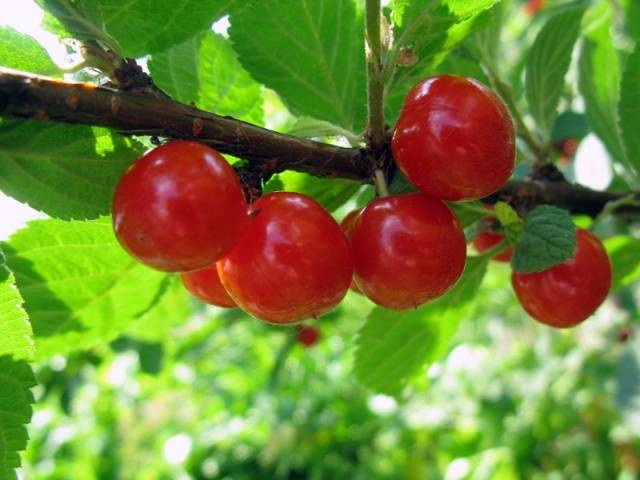

The Krasavitsa variety was bred by the Institute. Vavilov, year of carrying in the State Register - 1999. A bush with a wide crown grows to medium size and begins to bear fruit 3-4 years after placement in the garden. Wide-round berries of dark pink color with red flesh are distinguished by a mass of 3 g. Sweet and sour taste is estimated at 4 points. The beauty is a self-fertile variety, resistant to diseases, with a yield of up to 10 kg per bush.
Summer
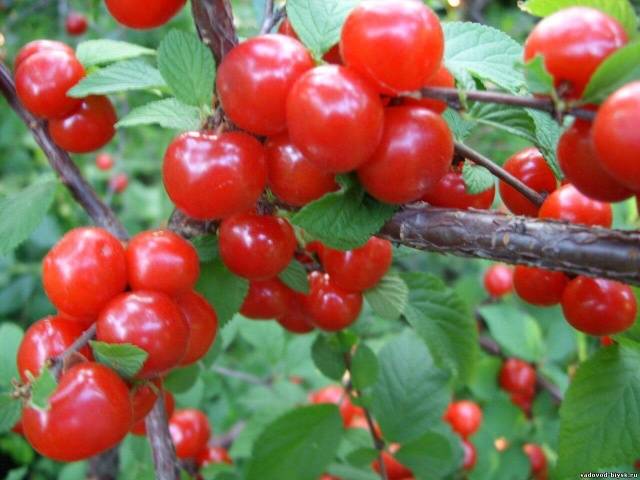

Seedlings of felt cherry Leto were bred by the Far Eastern Research Institute of Agriculture in 1957. In 1965, the variety was registered and approved for use throughout the Russian Federation. Summer is a universal cherry with light pink berries weighing 3.3 g and a large seed. The taste is bland, sweet and sour. Best of all, the Leto variety grows in the Khabarovsk Territory.
Dream
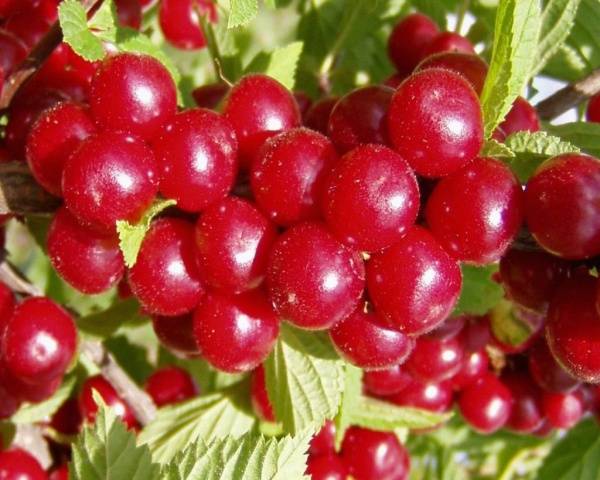

The dream belongs to promising varieties that grow well in all regions.It was created by the V.I. Vavilov in 1986. The dream forms a bush with a dense round crown, maroon berries weighing 3-3.3 g m and a thin skin.
Comment! The separation of berries from the variety is semi-dry.
Self-fertile
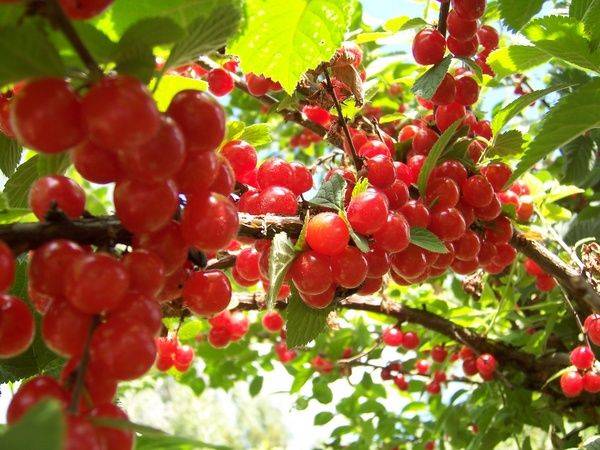

Almost all varieties of felt cherries are self-fertile. This means that without pollinators, they will give a meager harvest. Many plant a Chinese bush, gorge on berries and consider the variety self-fertile. Let's take a little look at this issue. A bush 1.5 m tall should give an average yield of 7 kg. This means that it is simply covered with berries during full ripening.
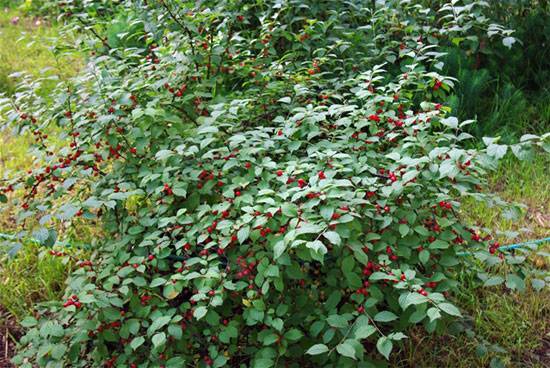

Is this your harvest, or did the Chinese woman give away only the prescribed 4% of the possible? In order for the berries to be enough, 2-3 varieties must be planted or a plum or apricot must grow at a distance of no more than 40 m. So the declared self-fertility of some varieties of felt cherries remains a big question. More often than others, such cultivars are considered not in need of pollination:
- Eastern;
- Children's;
- Summer;
- Dream;
- Light;
- Firework;
- Morning.
In the northern regions, especially in the Far East, felt cherry can be an excellent alternative to ordinary cherry. In the southern regions, it will diversify the diet and make it possible to feed children with vitamins without being forced.
Why prune cherries in the fall?
In autumn, pruning is carried out for the purpose of thinning and sanitation. Subject to removal:
- sick, old, dry branches;
- vegetation at the base of the trunk;
- shoots that grow inside the crown;
- dense, intertwined processes.
Together with the affected branches and debris, bacteria, insects, and fungal spores are removed from the leaves. This eliminates the possibility of wintering for pests.
After sanitizing treatment, the tree and the trunk circle are sprayed with a 5% urea solution. This fertilizer destroys pests, fungal and infectious pathogens.
Overgrown trees are thinned out to form the correct crown, unhindered penetration of sunlight and air.
In the fall, cherries are dormant, so pruning is easier. In the spring, active sap flow begins, buds bloom. Any interference with this process can cause gum flow.
Useful properties of fruits and their application
The fruits of this plant are very useful fresh, and various desserts, drinks are prepared from them, and preparations for the winter are made. The fruits are part of various confectionery products, and they are also frozen and dried.
I must say that since the berries have a delicate consistency, they are not stored for a long time, so they are processed freshly harvested.
In addition to nutritional value, fruits contain a lot of vitamins and minerals. These are vitamins C, B, P, PP, anthocyanins, catechins and flavonols, malic acid, fructose. There is more iron in them than in apples.
Thanks to such an abundance of nutrients, the fruits of this plant can rightfully be called medicinal. Their frequent consumption strengthens capillaries, improves digestion and appetite, as well as metabolism. The threat of heart attacks and strokes is reduced, since the substances contained in the fruits normalize blood pressure.
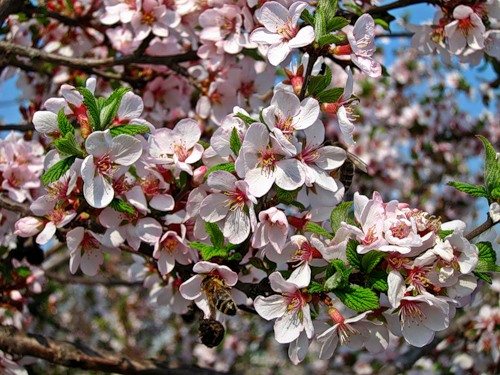

Choosing a sunny location
Before you start a berry beauty on your site, decide on the choice of a place. Cherry bushes do not like soil, to the surface of which groundwater is close. Excess moisture will lead to root rot.
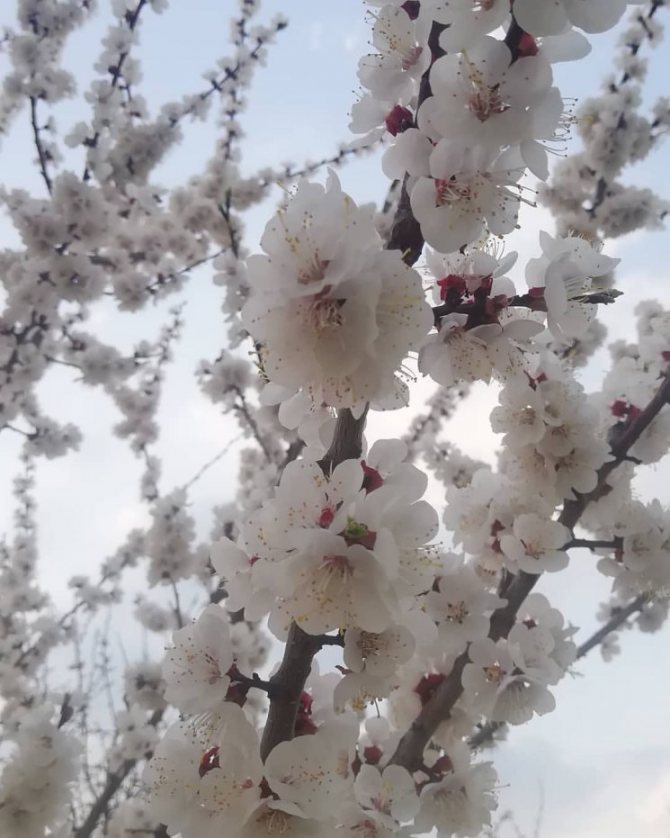

But if the area is very humid, choose elevated places for planting, or equip drainage and outflow of excess water.
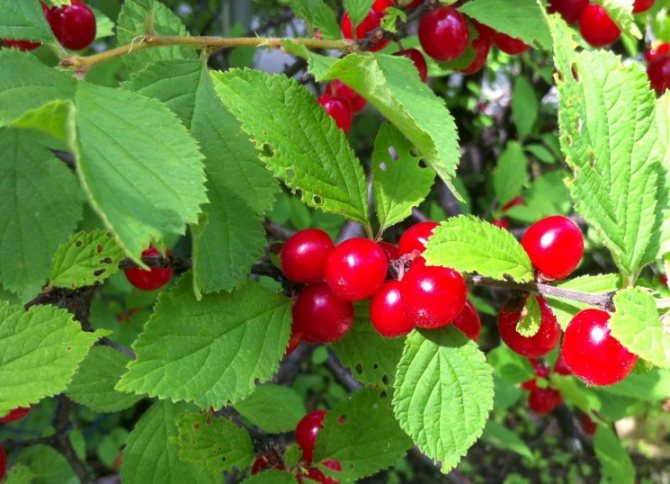

Felt cherry prefers to grow in sunny places for a reason. If the summer is rainy, in a dark corner of the garden, the tender cherries of the bush will rot.
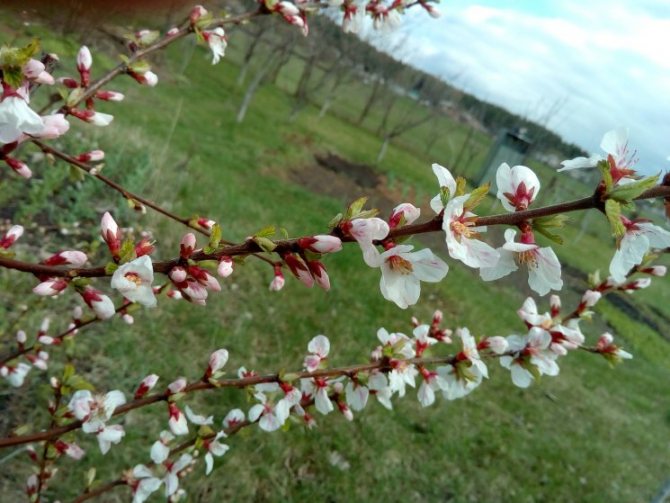

Removing overgrowth
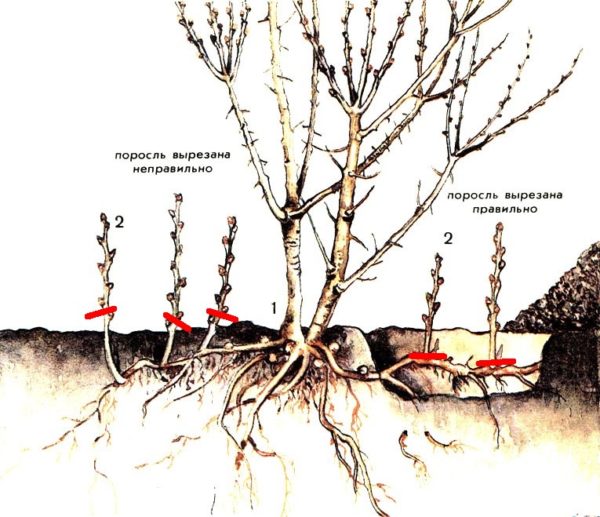

When maintenance work is not carried out at all or is carried out irregularly, many small cherry growths form in the vicinity of the mother plant. It draws nutrients from the soil and root system of the plant for its development. This leads to a decrease in yield and deteriorates the quality of the berries. Therefore, young shoots are uprooted.
Side bend
"Cloning" the mother bush is not a difficult procedure and is carried out in the spring as soon as the snow melts.
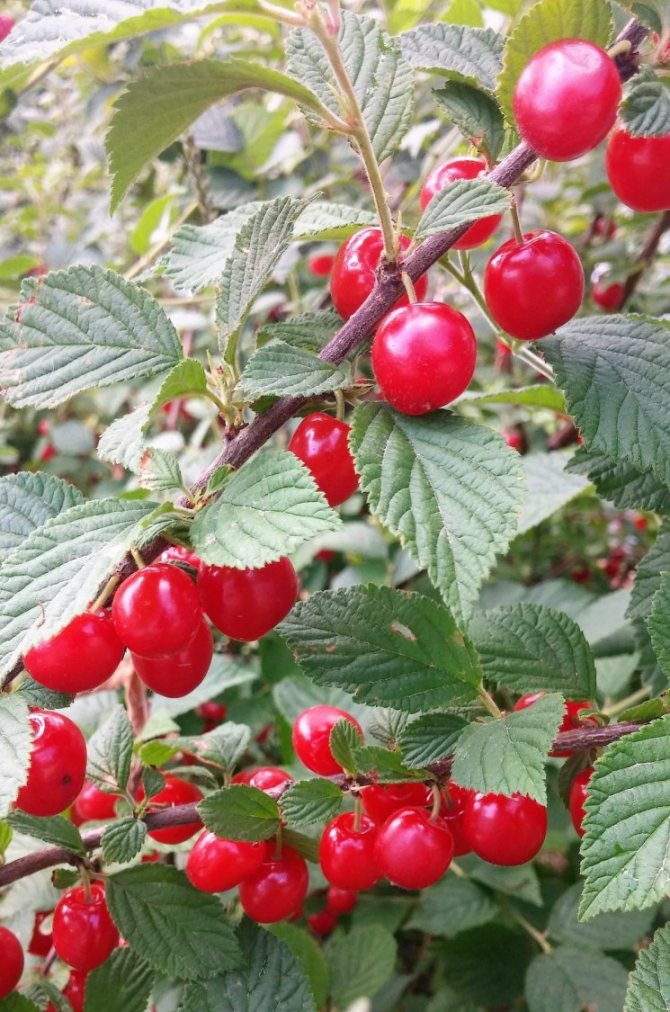

They choose the freshest, last year's shoot, bend it to the ground, put it in a pre-prepared groove, and sprinkle it with soil, tamping it.
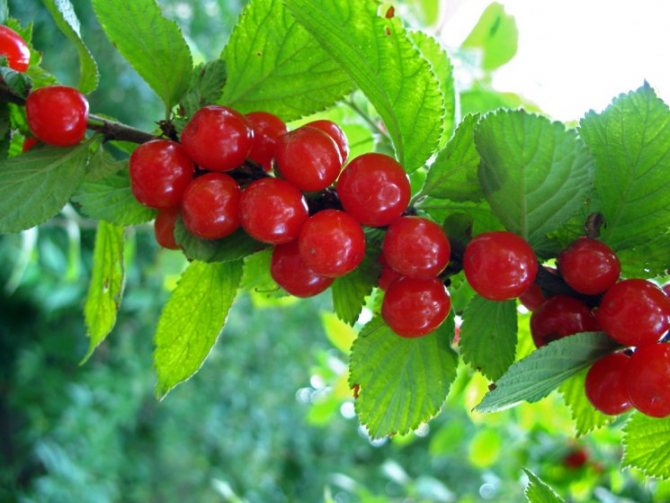

For closer contact with the ground, the twig is advised to "pin down" with a spear or bent wire. Do not forget to water it all summer and by autumn the cuttings will take root.
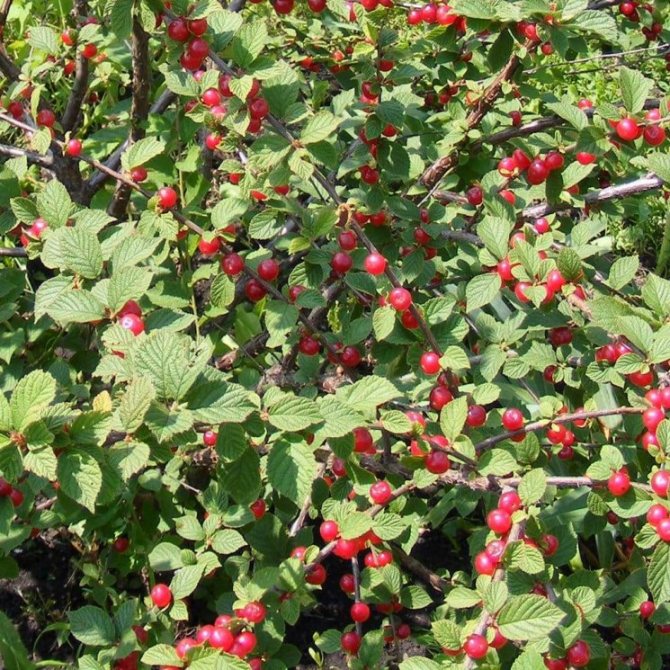

Felt cherry is not capricious in its care and its cultivation is within the power of the most inexperienced amateur. And if the plant is surrounded with care, attention and love, it will certainly reward you with lush flowering and a generous harvest of vitamins.
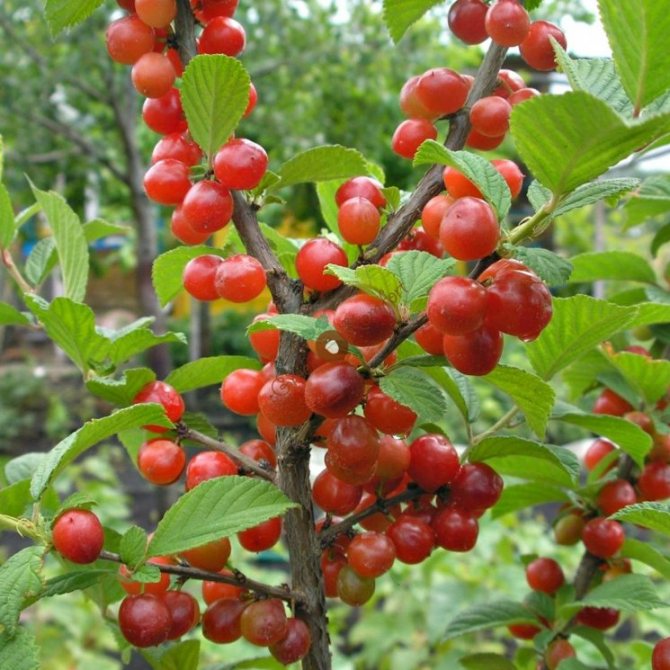

The importance of pruning
Felt cherry is a shrub form of the fruit tree native to China. The bush reaches a height of two meters, in width the shrub spreads to 1.5. If the bush cherry is not trimmed, it will take on a ball shape. Cherry pruning is essential: the tree rejuvenates and its lifespan is extended.
Dwarf cherry is distinguished by its unpretentiousness to growing conditions and does not grow only in a cold arctic climate (it can withstand frosts down to -30C). The tree fell in love with Russian gardeners for its high yield rates - up to 20 kg from one felt cherry. The crop is harvested in the second year after planting the seedling.
Pruning stimulates the formation of shoots, due to which the shrub is rejuvenated, filled with new strength. In addition, it is thanks to constant pruning that an increase in yield is achieved. A feature of the felt cherry is its tendency to thicken: the shrub will turn into a dense ball in a short time. An excess of old branches does not contribute to the formation of ovaries and the ripening of berries. This is due to a lack of sunshine in dense thickets and a lack of vitality in old branches.
A dense crown contributes to:
- the development of phyto-diseases;
- lack of sunlight;
- lack of air inside the crown;
- decrease in yield.
Agrarians recommend every spring to thin out the crown of the bush, remove excess growth, diseased / dry twigs. Sanitary pruning will not only form a beautiful crown of the correct shape, but also protect the crop from fungal infections. It is cherry trees that are prone to damage by phyto-fungi.
Felt cherry is an excellent rootstock for stone fruit trees, giving them the properties of unpretentiousness and compactness.
If the shrub is not pruned in a timely manner and regularly, this will lead to premature aging of the crop. Too dense crown will prevent bees from pollination of flowers, therefore it is necessary to make gaps for better access of insects and air.
Correct pruning makes it easier to care for your crop by keeping the trunk open. Can be easily whitewashed, harvested or treated with agrochemicals. Excessive thickening impedes free access, interferes with the necessary agromanipulations.
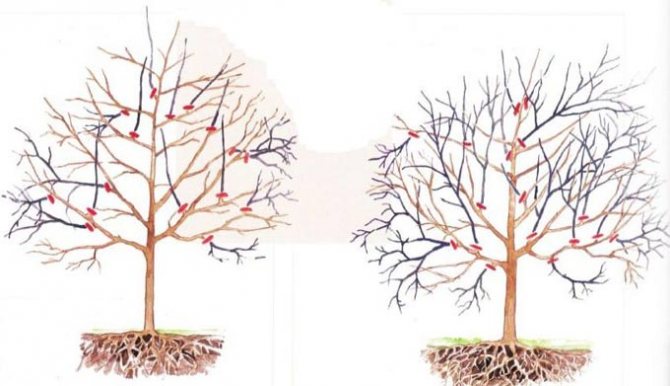

Autumn transplant
If the cherries need to be transplanted, then this is done in the fall, since in the spring the plant starts growing early.
Step-by-step execution of work:
- The stem is dug in a circle, stepping back from the trunk by 35 cm.
- The soil in the formed circle is watered abundantly.
- The main roots holding the plant are identified and filed down.
- Slices are cleaned with a knife.
Then they put strong poles under the freed root system and pull out the plant with their help. It is recommended to immediately transplant it into a previously prepared hole, the dimensions of which exceed the diameter of the earthen coma. In this case, the roots are carefully straightened so that they do not bend up.The pit is filled up, occasionally shaking the tree by the trunk to fill all the air voids.
An almost filled planting pit is well tamped, directing the force from the edge to the center. Then the remaining soil is poured and the transplanted plant is abundantly watered.
Benefits of pruning cherries
The felted crop should be pruned regularly. Thanks to agromanipulation, the plant forms correctly, looks proportional. Due to the normal density of the branches, the number of fruits increases, their quality - the cherries become large and tasty. By removing old branches, you will exclude the appearance of pests and diseases of the tree, which will be Pruning of bush felt garden cherry, made in autumn, will maintain the level of fruiting, eliminate thickening of the bushes. At the same time, a beautiful, neat crown is formed, which eliminates the complexity of care and picking berries. Deleting branches will not be difficult if you know the technology of work.
Rule 3. Feed the cherries
It is advisable to combine fertilization in the autumn period with watering. So they will quickly get deep into the soil to the horse system. It's great if you manage to feed the cherries at the very beginning of autumn, because later the tree will literally go into hibernation and use fertilizers only in early spring, which, in fact, is also not bad.
What to use as fall fertilizer? Anything. The main thing is that there is no nitrogen in the top dressing, which can activate growth processes and reduce the winter hardiness of the plant. If there is compost, you can use it (for trees from 1 to 7 years old - 1.5-2 kg per 1 square meter of the trunk circle, for trees over 7 years old - 2.5-3 kg), mineral fertilizers are also suitable. The ideal option is phosphorus plus potassium (for young trees - 2 tablespoons of superphosphate and 1 tablespoon of potassium chloride per 1 square meter, for fruit-bearing trees - 3 tablespoons of superphosphate and 1.5 tablespoons of potassium chloride ).
A rich harvest cannot be obtained without proper feeding
Note to home breeders
To breed cherry bushes yourself, you do not need to be an agronomist-breeder. Felt cherry propagation is carried out by cuttings, layering and seeds.
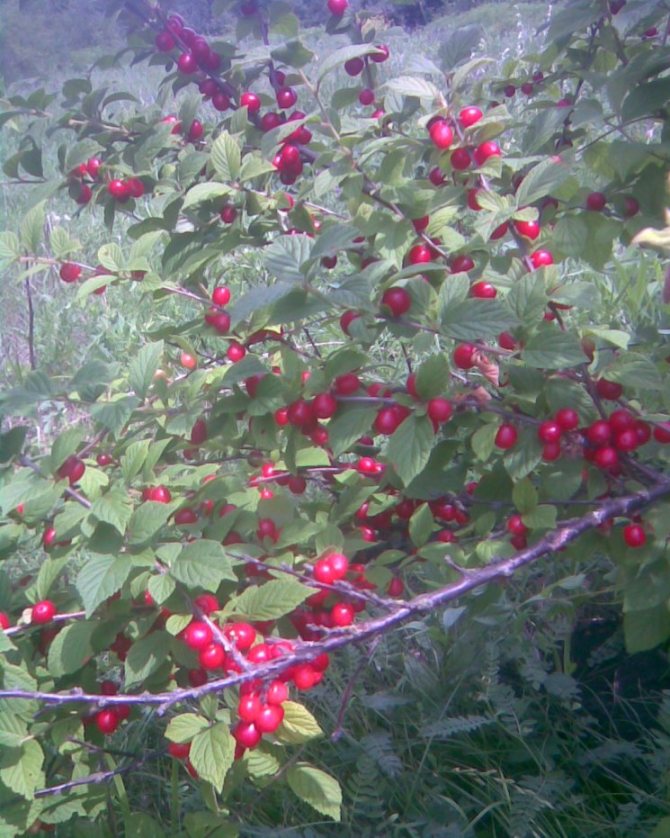

The seed bushes option is suitable for creating green fences. In this case, the yield is not important, because the offspring from the seeds cannot boast of large fruits.
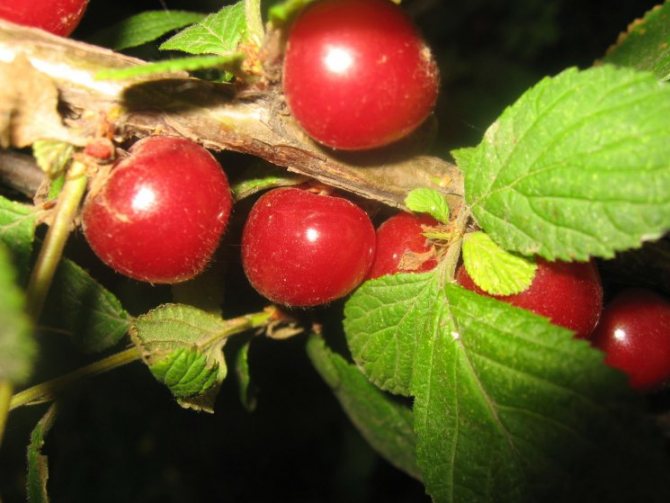

Reproduction methods
In summer cottages, felt cherries are propagated in several ways:
- seeds;
- cuttings;
- layering.
Let's dwell on each type in more detail.
Seeds
The easiest option to breed felt cherries in your own summer cottage is to plant seeds in open ground. For this, juicy berries are taken from the most productive bushes and the seeds are separated. Sowing is done in mid-autumn or spring. When planting in spring, the seeds require preliminary stratification at a temperature of 3-5 ° C.
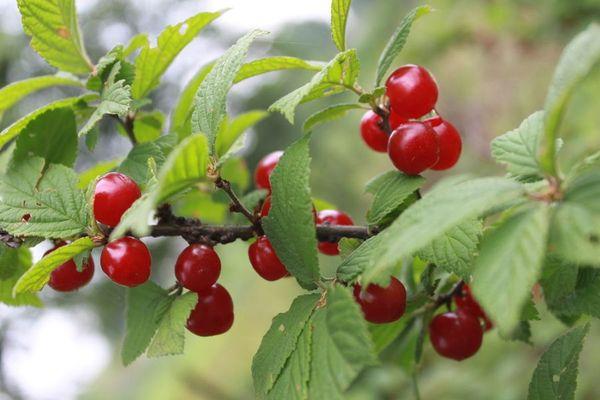

Breeding felt cherries with homemade seeds allows you to preserve all the characteristics of the mother plant and get rich yields with excellent taste of berries.
Cuttings
Felt cherries can also be propagated by cuttings. For this, the middle part of annual green twigs is used. Cuttings are placed in a nutrient solution that stimulates the formation of the root system for a day, and then planted in open ground. Within a month after planting, they take root and grow.
Layers
Very rarely, felt cherries are propagated by horizontal layers. For this, the lower healthy branch is carefully bent down and sprinkled with earth. When strong roots appear, the branch is separated from the mother bush, and the plant is transplanted to a permanent place.
See also
Is it possible and how to grow an apricot from a stone in the country, planting and care
To read
The need for pruning
Early fruiting, short growth and spreading of the crown lead to a rapid drying out of the trunk. Pruning dwarf felted cherries correctly in the fall will improve yield and longevity.It is necessary to carry out molding, sanitary renewal of the crown to obtain large berries, remove diseased and insect-affected branches. The goal of the activities is full trimming:
Culture is not only cut in the fall. Spring and summer shoot removal is allowed.
Rule 2. Water the trees well
It is possible to carry out water-charging cherry irrigation immediately after dug up and loosened the soil around the trunk. Such pre-treatment of the soil will allow moisture to penetrate deep into the soil, and, as you know, wet soil freezes much more slowly than dry.
But in order to wet the soil as deeply as possible, at least two buckets of water must be poured under each tree. In this case, it is advisable to use water several degrees warmer than the air temperature on the day of irrigation. In order to prevent irrigation water from spreading over the site, the zone of the near-trunk circle can be limited by a trench 10-12 cm deep.
Cherry orchard age and pruning
Felt cherry is a bush crop whose twigs are shortened by ½ or 1/3 size. Fruiting of stone fruit occurs only on last year's branches. Therefore, semi-skeletal and skeletal shoots are cut to the level of lateral branches in order to accelerate their growth and upward direction. During spring work, it is permissible to shorten the elements at the level of the sleeping bud. For a better transfer of the procedure by cherries, sections of skeletal and semi-skeletal material are alternated after a year. Annual branches do not affect, only long ones are removed (about 50 cm).
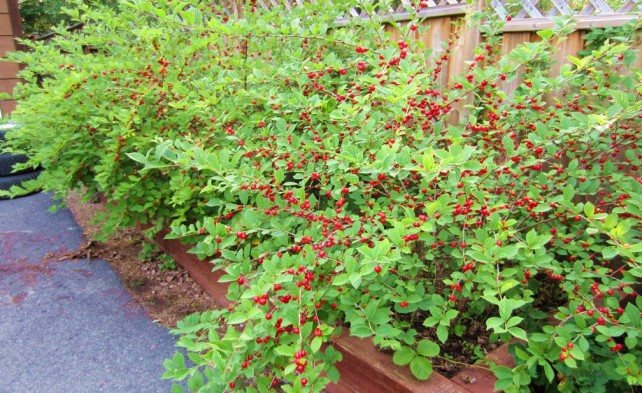

How to work with young cultures?
Stone fruit varieties differ in the speed of crown development, so there is no need to tighten it with pruning. Branches are removed annually before bud formation or in autumn. During the execution of garden activities, the following nuances must be taken into account:
- annual plants will freeze if shoots are removed before wintering;
- young plantings are cut off later than the rest;
- work only with a saw or a sharp knife, removing weakened elements under the ring;
- damaged areas are coated with garden varnish;
- knots should be spaced 10-13 cm apart.
Crown formation is possible only for seedlings from 2 years old. Molding is combined with thinning, removing branches over 50 cm in length. The work adheres to the following scheme:
- Choose 6 main processes, 8-15 cm apart from each other.
- The rest of the vegetation is cut out, giving the crown a ring shape.
- Branches facing the trunk are removed.
- Leave one parallel element at an acute angle.
Thus, an adult cherry tree has about 15 main branches. They expand without restriction, but for convenient collection of fruits they are periodically thinned out.
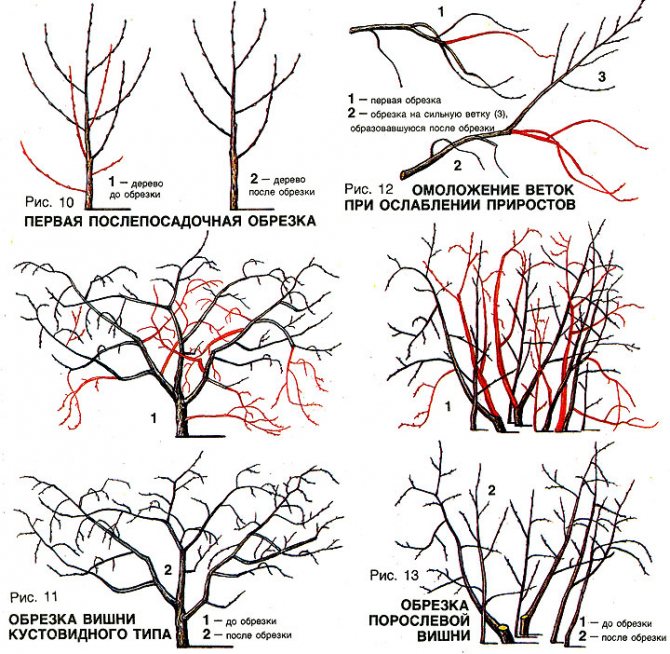

Rules for pruning fruiting crops
Felt cherry loses its crown volume with age. On the bases of large knots, "tops" shoots appear. In order to improve the quality of the harvest, the cherry orchard is rejuvenated, removing no more than 1-2 meters of the crown. Exceeding the norm will lead to death or disease of the tree. The cut is performed over the branches with fruits, in several stages, if the work has not been performed for several years.
Features of rejuvenation of old plants
On old trees, dried out, not fruitful and diseased twigs are removed. Slices are made to the level of healthy material. The tilted crown is also removed.
Nuances of the procedure: time, tools
The agrotechnical season depends on the varietal variety of the tree. Molding pruning of cherries is relevant in the spring before the start of sap flow and bud formation. It is important to remove only the skeletal and lateral branches. Sanitary and anti-aging measures are carried out in the fall, after harvesting the fruits and falling foliage.During the sanitary cut, it is necessary to completely remove the diseased, damaged material directed towards the trunk. During the summer growing season, they work with cherries affected by diseases. It is recommended to rejuvenate stone fruits after 8 years in early spring or mid-autumn.
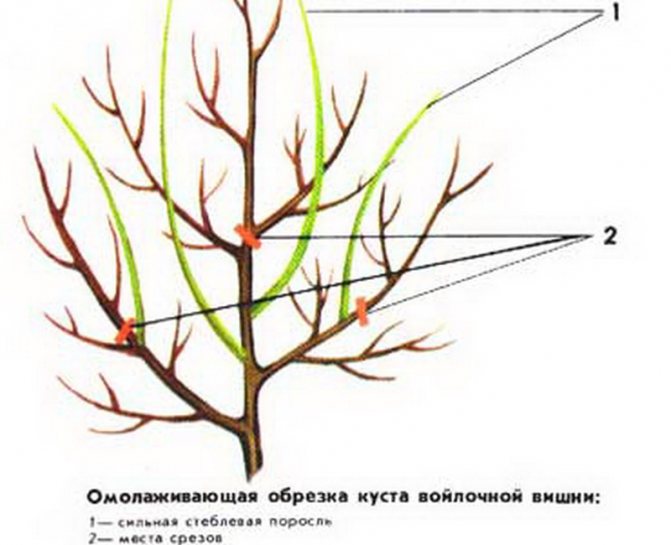

What tool can you work with?
The quality of agricultural procedures depends on the use of tools. You will need:
Tools must be treated with antiseptics so that the plants do not infect fungal or infectious diseases. The cut points must be smeared with garden varnish.
How to make a garden pitch?
A special plant putty is needed for treating open cuts, damaged wood, or burns. Novice gardeners can purchase Petrolatum, but experienced agronomists recommend making the following formulations for scar tissue on their own:
- nigrol. You will need 1 kg of paraffin, nigrol and rosin, which are separately heated. Rosin with paraffin is carefully poured into hot nigrol, thoroughly mixed. Before use, you can fill in the ash of the bark and be sure to warm up the putty;
- on wood alcohol. They work as a garden pitch during the cold season. For cooking, mix melted bacon and fine rosin in proportions of 1:16. The liquid is heated, brought to a homogeneous state and combined with 8 parts of alcohol;
- on beeswax. To make a solution, prepare beeswax, rosin or resin, linseed oil in a ratio of 4: 20: 1. First, beeswax is melted, and then rosin is injected into it. After mixing, add flax oil. After boiling, add 2 parts of charcoal to the mixture;
- on lard. It is required to melt 1 part of lard, add 2 parts of wax to it and bring to a homogeneous state. Then 4 parts of fine rosin are introduced into the mixture and boiled for 30 minutes. The mass must be poured into cold water and kneaded.
For high-quality healing of sections, heteroauxin can be added to the garden variety at the rate of 1 tablet per 1 liter. You can use the solution at any time of the year.
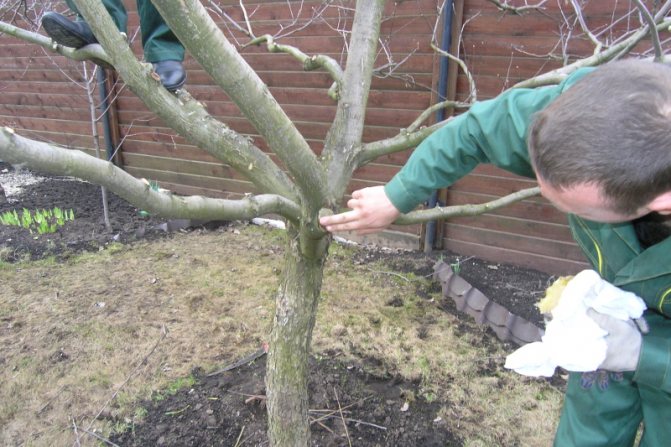

Landing rules
In order for the planting of a felt cherry bush to be successful, it is recommended to take into account the recommendations and the following rules:
- Choose a suitable place and prepare a hole, which should be the same in diameter and 50 cm deep.
- Place top dressing at the bottom - a vitamin complex consisting of fertilizers and minerals: phosphorus, potassium, lime. Cut the rhizome to 25 cm and lower it, and cover it with earth on top.
- See that the root cap is above the ground. When it deepens, the plant may die.
- Finish planting by watering in the open field and mulch the soil.
Cultivation of felt cherries consists in working with the ground, namely: weeding, loosening around the tree trunk, timely watering and fertilizing.
Diseases and pests and other growing problems
Moniliosis
Most often, felt cherry suffers from moniliosis - a disease caused by a fungus and affecting branches, fruit ovaries, leaves. They fight this disease with the help of 1% Bordeaux liquid, which is applied to plants by spraying. They do this before the flower buds open. The preparation HOM is also suitable, the solution is prepared at the rate of 25-30 g per 10 liters. water. When the felted cherry has faded, for prevention purposes, you can spray it again with these agents.
| I must say that this disease most often begins in damp, cool weather, therefore, when such weather drags on in spring, it is necessary to do two treatments with the above means with an interval of two weeks. |
Pocket disease
Pocket disease affects felt cherries, as well as related crops, plum and peach. It is caused by a fungus that affects the ovaries. There is no seed in the affected fruits, they look more like sacs. The spores of the fungus mature in these sacs.If this disease is not dealt with, then it can deprive the gardener of 1/5 of the crop, and subsequently the plants may die altogether.
To fight the infection, you need to cut off all the affected parts of the bush and burn it, the same is done with fallen fruits and foliage. In early spring, twice with a period of a week, the bushes are treated with a 1% solution of copper sulfate or Bordeaux liquid 3%. In the fall, when the leaves fall, repeat the same procedure.
Pests
Among the pests that infect felt cherry, the most famous are cherry weevils, gall mites, scale insects, and aphids. When a plant is damaged by these pests, it is necessary to use various pesticides, for example, Aktara, Aktellik, Karbofos.
Freezing shoots
Freezing of the shoots can also be the reason for the poor harvest. Although, as mentioned earlier, felt cherry is a very frost-resistant plant, frequent temperature drops, alternating thaws with frosts are dangerous for it.
Root collar heating
Root collar podipation is another extremely common felt cherry disease. If the snow falls in a thick layer on the non-frozen ground, as often happens especially in the middle lane, then the root collar underpins, which leads to the death of the plant. In spring it may even bloom, but then it dries up. Therefore, it is advisable to mark places on the site where there is no large accumulation of snow and plant felt cherries there.
There is one an old but effective method of preventing suspicion... It is necessary to dig up the plants in the fall at a distance of about 20 cm. The depth of the hole should be no more than 10 cm. Coarse river sand is poured into this hole. It will be even safer if you mix the sand in a one-to-one ratio with foam crumbs.
Thus, there is nothing difficult in growing and caring for felt cherries. If you take into account all the recommendations, then this wonderful fruit crop will decorate the site with its flowering and will bring large yields of delicate vitamin fruits for many years.
Photo credits: magleon, LadyChudo, universman, russicoon, lyudmilanickitina, linaavel, vasi.zorina, Natalia Isichenko, swetlana7151.
Autumn care for a good harvest
Although cherries tolerate drought and low temperatures well, they still need care and quality preparation for the winter. In summer, the plant needs protection from diseases and pests. In a drought, the tree must be watered and must be fed with fertilizers. With proper care of cherries in autumn, the tree pleases with abundant flowering and gives a high yield.
Digging the soil
In autumn, the soil in the near-trunk circle must be dug to a depth of 15 cm. It is not necessary to dig deeper so as not to harm the roots of the plant. Finish the processing of the trunk circle by loosening the soil with a rake. The parts of the weed roots found during the digging must be removed.
Watering
Immediately after digging and loosening the soil, the cherry is watered abundantly. Due to the peculiar preparation before moistening, the water penetrates deep into the soil and does not freeze longer. In order for the watering to be of high quality and the water to penetrate to a great depth, at least two buckets are poured under each tree. In this case, the water should be used slightly warmer than the surrounding air on the day of watering. To reduce the consumption of water and prevent it from spreading over the site, the near-trunk circle is limited to a trench 10 cm deep.
Top dressing
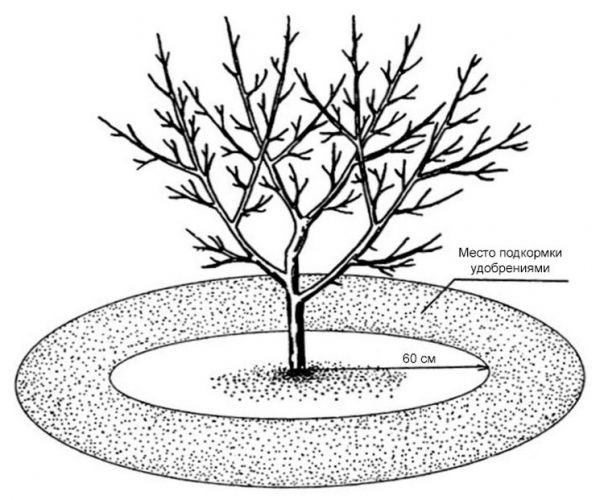

It is advisable to water in conjunction with fertilization. This will help the beneficial substances quickly penetrate the roots of the tree. It is recommended to feed cherries in the fall in the first days of September, until the plant has time to go into the dormant stage. This will make it possible to assimilate the fertilizer immediately, and not wait for the onset of spring.
You can fertilize cherries with compost. It is applied in the following amount:
- if the age of the tree does not exceed 7 years, 2 kg are applied for each square meter of the near-trunk circle of soil;
- for older trees, the amount of compost is increased to 3 kg.
Mineral complexes with a predominance of potassium and phosphorus can be used as top dressing:
- it is enough for young trees to add 1 tbsp for every square meter of soil. l. potassium chloride and 2 tbsp. l. superphosphate;
- for fruiting plants, this rate is increased by 1.5 times.
Disease prevention
Preventive treatment of cherries from diseases and pests in the fall begins with cleansing lichen, moss and loose bark from the trunk. It is convenient to perform this procedure with a metal bristle brush. Then the plant residues in the trunk circle are collected and burned. Often during this, egg clutches of pests are found. They are also destroyed by hand.
With a moderate infection of plants by pests, cherries are treated with folk remedies:
- ash and soap solution prepared from 10 liters of water, 400 g of ash and 50 g of liquid soap;
- a solution of 50 g of birch tar and 10 liters of water;
- infusion of 1 kg of chamomile and 10 liters of water.
If there are too many pests, cherries are treated with chemical insecticides "Karbofos", "Aktellik" or "Bankol". As a preventive measure, the plant is sprayed with Bordeaux liquid, using a solution concentration of 1%. For young trees, 2 liters of solution is enough, and for fruiting trees, the volume is increased to 10 liters. At the same time, the trunk circle is sprayed.
Warming and whitewashing of boles
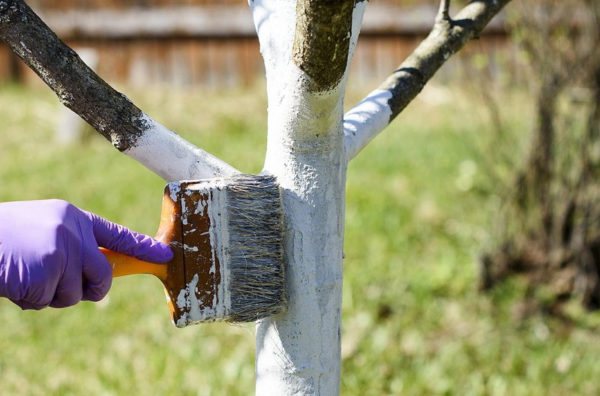

Since the climate in Russia is changeable, it is worth preserving the fruit tree from the vagaries of the weather in advance. After all, frosts that hit before the establishment of snow cover can destroy a young plant. Therefore, for young cherries up to four years old, the stems are wrapped in burlap, old newspapers and tied on top with spruce branches. Before this, it is recommended to wrap the trunk at the base with a plastic net to prevent damage by rodents.
In mature trees, trunks are whitened for additional protection. A layer of whitewash will help protect the tree from too bright sun in winter. If you add a little iron sulfate to the lime, then such a whitewash will scare away rodents. The trunks are treated with lime after the rainy season is over, so that the paint layer remains on the plant longer.
In spring, during flowering, flowers and ovaries sometimes crumble from the cherry. This is due to the high acidity of the soil. Therefore, it is recommended to apply lime fertilizers to the soil every 5 years. They will help preserve the green part of the plant.
Bone babies
The germination rate of seeds of Chinese cherry is quite high - 7-8 seeds germinate out of ten seeds. Planting material is harvested in the summer.
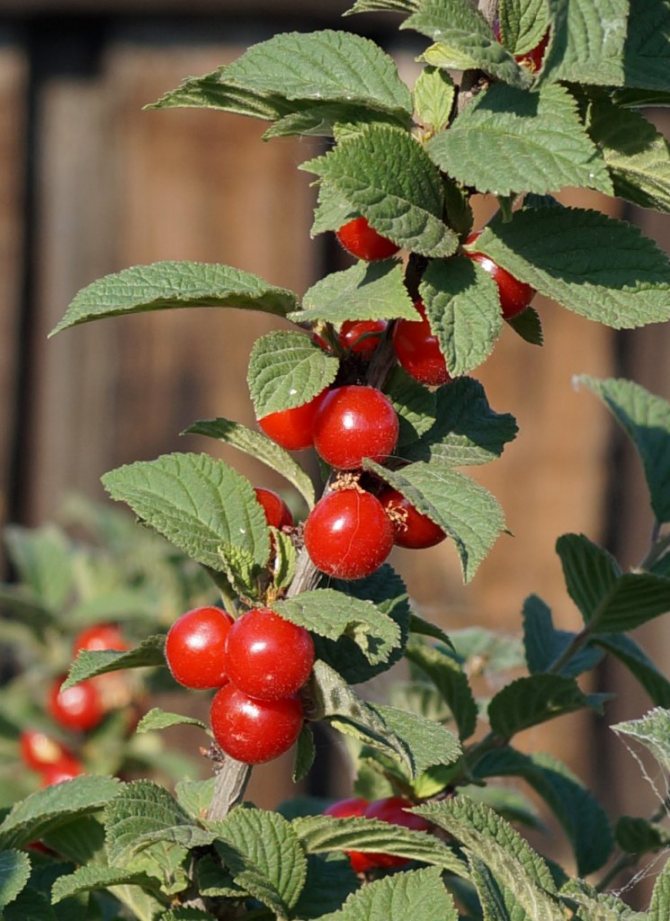

The seeds, washed and peeled from the pulp, are dried (not in the sun!) And stored until October, mixed with sand.
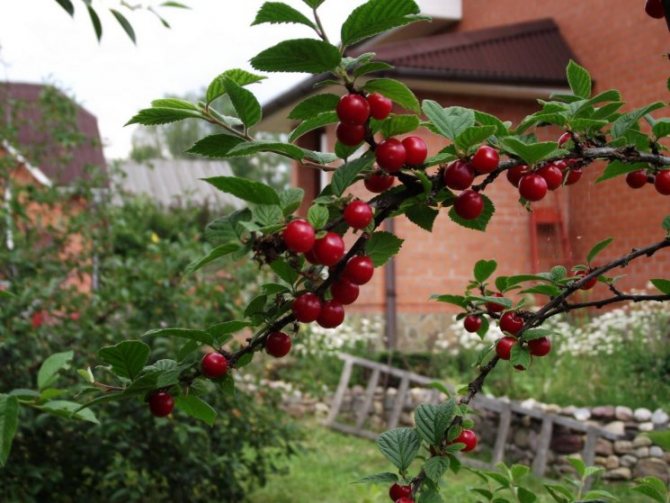

In the fall, having chosen a permanent place for the bushes, they make a groove 6 cm deep, plant seeds, sprinkle with sawdust and cover them with earth on top. In the spring, seedlings will appear, which by autumn will reach a half-meter growth.
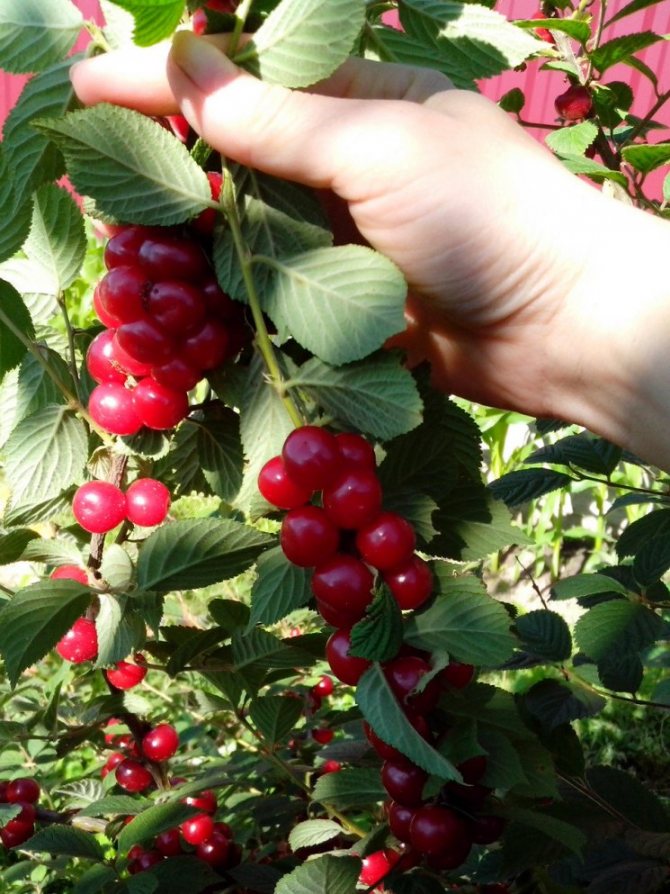

The main mistakes when growing
In arid regions, felt cherry requires autumn fertilization and subsequent abundant watering before preparing for the winter season. Experienced gardeners practice the autumn digging of the trunk circle to a shallow depth, saturating the shrub with oxygen.
In regions with a harsh climate and late frosts, delaying the flowering period by several weeks will help save fruiting. For this, in winter, a dense snowdrift is formed around the trunk circle, which does not melt for a long time under the shadow of the branches. Thus, late frosts occur before flowering begins, and fruiting remains at a high level.
Prophylaxis
To prevent excessive overgrowth formation, the state of the trunk circle is constantly monitored. All fallen berries and seeds are collected. Otherwise, after overwintering, they will sprout with the onset of spring. A spreading tree growing next to cherries relieves young shoots well. But in this case, the mother plant will also be deprived of light.
The choice of cherry variety also influences the growth of the growth. Usually it is given by own-rooted seedlings. If cherries are grown in a seed yard, they do not form root shoots.

